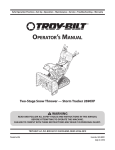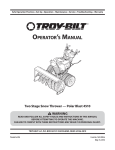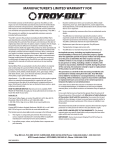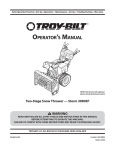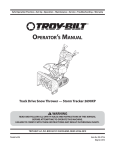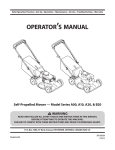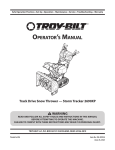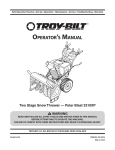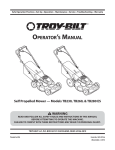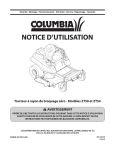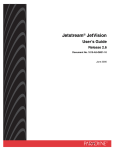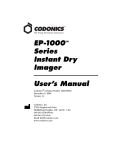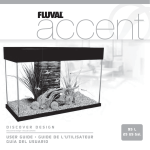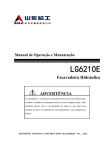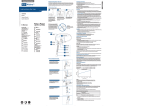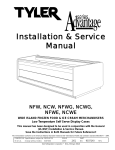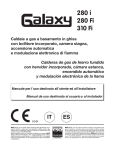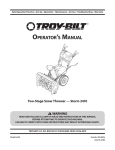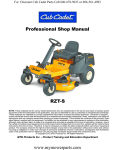Download OPERATOR`S MANUAL
Transcript
4BGF0QFSBUJPO1SBDUJDFTt4FU6Qt0QFSBUJPOt.BJOUFOBODFt4FSWJDFt5SPVCMFTIPPUJOHt8BSSBOUZ
OPERATOR’S MANUAL
Two-Stage Snow Thrower — Storm Tracker 2690XP
WARNING
READ AND FOLLOW ALL SAFETY RULES AND INSTRUCTIONS IN THIS MANUAL
BEFORE ATTEMPTING TO OPERATE THIS MACHINE.
FAILURE TO COMPLY WITH THESE INSTRUCTIONS MAY RESULT IN PERSONAL INJURY.
TROY-BILT LLC, P.O. BOX 361131 CLEVELAND, OHIO 44136-0019
Printed In USA
Form No. 769-08991
(July 22, 2013)
1
To The Owner
Thank You
Thank you for purchasing a Troy-Bilt Snow Thrower. It was
carefully engineered to provide excellent performance when
properly operated and maintained.
Please read this entire manual prior to operating the equipment.
It instructs you how to safely and easily set up, operate and
maintain your machine. Please be sure that you, and any other
persons who will operate the machine, carefully follow the
recommended safety practices at all times. Failure to do so could
result in personal injury or property damage.
All information in this manual is relative to the most recent
product information available at the time of printing. Review
this manual frequently to familiarize yourself with the machine,
JUTGFBUVSFTBOEPQFSBUJPO1MFBTFCFBXBSFUIBUUIJT0QFSBUPST
Manual may cover a range of product specifications for various
models.
Characteristics and features discussed and/or illustrated in this
manual may not be applicable to all models. We reserve the
right to change product specifications, designs and equipment
without notice and without incurring obligation.
If applicable, the power testing information used to establish
the power rating of the engine equipped on this machine can be
GPVOEBUXXXPQFJPSHPSUIFFOHJOFNBOVGBDUVSFSTXFCTJUF
If you have any problems or questions concerning the machine,
phone a authorized Troy-Bilt service dealer or contact us directly.
5SPZ#JMUT$VTUPNFS4VQQPSUUFMFQIPOFOVNCFSTXFCTJUF
address and mailing address can be found on this page. We want
to ensure your complete satisfaction at all times.
Throughout this manual, all references to right and left side of the
machine are observed from the operating position
Table of Contents
Safe Operation Practices ........................................ 3
Assembly & Set-Up .................................................. 7
Controls ...................................................................12
Operation ................................................................15
Maintenance & Adjustments ................................16
Service .....................................................................19
Troubleshooting .....................................................21
Replacement Parts ................................................ 22
Attachments & Accessories .................................. 23
Warranty ..................................................Back Cover
Record Product Information
MODEL NUMBER
Before setting up and operating your new equipment, please
locate the model plate on the equipment and record the
information in the provided area to the right. You can locate the
NPEFMQMBUFCZTUBOEJOHBUUIFPQFSBUPSTQPTJUJPOBOEMPPLJOH
down at the rear of the frame. This information will be necessary,
should you seek technical support via our web site, Customer
Support Department, or with a local authorized service dealer.
SERIAL NUMBER
Customer Support
Please do NOT return the machine to the retailer or dealer without first contacting the Customer Support Department.
If you have difficulty assembling this product or have any questions regarding the controls, operation, or maintenance of
this machine, you can seek help from the experts. Choose from the options below:
◊
Visit us on the web at www.troybilt.com
See How-to Maintenance and Parts Installation Videos at www.troybilt.com/tutorials
2
◊
Call a Customer Support Representative at (800) 828-5500 or (330) 558-7220
◊
8SJUFUP5SPZ#JMU--$t10#PYt$MFWFMBOE0)t
Important Safe Operation Practices
2
WARNING! This symbol points out important safety instructions which, if not followed,
could endanger the personal safety and/or property of yourself and others. Read and follow
all instructions in this manual before attempting to operate this machine. Failure to comply
with these instructions may result in personal injury.
When you see this symbol. HEED ITS WARNING!
CALIFORNIA PROPOSITION 65
WARNING! Engine Exhaust, some of its constituents, and certain vehicle components
contain or emit chemicals known to State of California to cause cancer and birth defects
or other reproductive harm.
DANGER: This machine was built to be operated according to the safe operation practices in
this manual. As with any type of power equipment, carelessness or error on the part of the
operator can result in serious injury. This machine is capable of amputating fingers, hands,
toes and feet and throwing foreign objects. Failure to observe the following safety
instructions could result in serious injury or death.
Training
Preparation
Read, understand, and follow all instructions on the
machine and in the manual(s) before attempting to
assemble and operate. Keep this manual in a safe place for
future and regular reference and for ordering replacement
parts.
Thoroughly inspect the area where the equipment is to be used.
Remove all doormats, newspapers, sleds, boards, wires and other
foreign objects, which could be tripped over or thrown by the
auger/impeller.
2.
Be familiar with all controls and their proper operation.
Know how to stop the machine and disengage them
quickly.
3.
Always wear safety glasses or eye shields during operation
and while performing an adjustment or repair to protect
your eyes. Thrown objects which ricochet can cause serious
injury to the eyes.
/FWFSBMMPXDIJMESFOVOEFSZFBSTPGBHFUPPQFSBUFUIJT
NBDIJOF$IJMESFOBOEPWFSTIPVMESFBEBOEVOEFSTUBOE
the instructions and safe operation practices in this manual
and on the machine and be trained and supervised by an
adult.
2.
Do not operate without wearing adequate winter outer
garments. Do not wear jewelry, long scarves or other loose
clothing, which could become entangled in moving parts.
Wear footwear which will improve footing on slippery
surfaces.
Never allow adults to operate this machine without proper
instruction.
3.
Use a grounded three-wire extension cord and receptacle
for all machines with electric start engines.
5.
Thrown objects can cause serious personal injury. Plan
your snow-throwing pattern to avoid discharge of material
toward roads, bystanders and the like.
Adjust auger housing height to clear gravel or crushed rock
surfaces.
5.
Disengage all control levers before starting the engine.
Keep bystanders, pets and children at least 75 feet from the
machine while it is in operation. Stop machine if anyone
enters the area.
Never attempt to make any adjustments while engine is
running, except where specifically recommended in the
PQFSBUPSTNBOVBM
7.
Exercise caution to avoid slipping or falling, especially
when operating in reverse.
7.
Let engine and machine adjust to outdoor temperature
before starting to clear snow.
3
Safe Handling of Gasoline
5.
To avoid personal injury or property damage use extreme care
in handling gasoline. Gasoline is extremely flammable and the
vapors are explosive. Serious personal injury can occur when
gasoline is spilled on yourself or your clothes which can ignite.
Wash your skin and change clothes immediately.
Never run an engine indoors or in a poorly ventilated area.
Engine exhaust contains carbon monoxide, an odorless
and deadly gas.
Do not operate machine while under the influence of
alcohol or drugs.
7.
Muffler and engine become hot and can cause a burn. Do
not touch. Keep children away.
a.
Use only an approved gasoline container.
b.
Extinguish all cigarettes, cigars, pipes and other
sources of ignition.
8.
Exercise extreme caution when operating on or crossing
gravel surfaces. Stay alert for hidden hazards or traffic.
c.
Never fuel machine indoors.
d.
Never remove gas cap or add fuel while the engine is
hot or running.
Exercise caution when changing direction and while
operating on slopes. Do not operate on steep slopes.
Plan your snow-throwing pattern to avoid discharge
towards windows, walls, cars etc. Thus, avoiding possible
property damage or personal injury caused by a ricochet.
Never direct discharge at children, bystanders and pets or
allow anyone in front of the machine.
Do not overload machine capacity by attempting to clear
snow at too fast of a rate.
Never operate this machine without good visibility or light.
Always be sure of your footing and keep a firm hold on the
handles. Walk, never run.
Disengage power to the auger/impeller when transporting
or not in use.
Allow machine to cool at least 5 minutes before
storing.
Never operate machine at high transport speeds on
slippery surfaces. Look down and behind and use care
when backing up.
Never fill containers inside a vehicle or on a truck
or trailer bed with a plastic liner. Always place
containers on the ground away from your vehicle
before filling.
If the machine should start to vibrate abnormally, stop
the engine, disconnect the spark plug wire and ground it
against the engine. Inspect thoroughly for damage. Repair
any damage before starting and operating.
If possible, remove gas-powered equipment from
the truck or trailer and refuel it on the ground. If this
is not possible, then refuel such equipment on a
trailer with a portable container, rather than from a
gasoline dispenser nozzle.
Disengage all control levers and stop engine before you
leave the operating position (behind the handles). Wait
until the auger/impeller comes to a complete stop before
unclogging the chute assembly, making any adjustments,
or inspections.
Never put your hand in the discharge or collector openings.
Always use the clean-out tool provided to unclog the
discharge opening. Do not unclog chute assembly while
engine is running. Shut off engine and remain behind
handles until all moving parts have stopped before
unclogging.
Use only attachments and accessories approved by the
manufacturer (e.g. wheel weights, tire chains, cabs etc.).
20.
When starting engine, pull cord slowly until resistance
is felt, then pull rapidly. Rapid retraction of starter cord
(kickback) will pull hand and arm toward engine faster than
you can let go. Broken bones, fractures, bruises or sprains
could result.
If situations occur which are not covered in this manual, use
care and good judgment. Contact Customer Support for
assistance and the name of your nearest servicing dealer.
e.
Allow engine to cool at least two minutes before
refueling.
f.
Never over fill fuel tank. Fill tank to no more than ½
inch below bottom of filler neck to provide space for
fuel expansion.
g.
Replace gasoline cap and tighten securely.
h.
If gasoline is spilled, wipe it off the engine and
equipment. Move machine to another area. Wait 5
minutes before starting the engine.
i.
Never store the machine or fuel container inside
where there is an open flame, spark or pilot light
(e.g. furnace, water heater, space heater, clothes
dryer etc.).
j.
k.
l.
m. Keep the nozzle in contact with the rim of the fuel
tank or container opening at all times until fueling is
complete. Do not use a nozzle lock-open device.
Operation
4
Do not put hands or feet near rotating parts, in the auger/
impeller housing or chute assembly. Contact with the
rotating parts can amputate hands and feet.
2.
The auger/impeller control lever is a safety device. Never
bypass its operation. Doing so makes the machine unsafe
and may cause personal injury.
3.
The control levers must operate easily in both directions
and automatically return to the disengaged position when
released.
Never operate with a missing or damaged chute assembly.
Keep all safety devices in place and working.
SECTION 2 — IMPORTANT SAFE OPERATION PRACTICES
Clearing a Clogged Discharge Chute
Hand contact with the rotating impeller inside the discharge
chute is the most common cause of injury associated with snow
throwers. Never use your hand to clean out the discharge chute.
To clear the chute:
4)655)&&/(*/&0''
2.
8BJUTFDPOETUPCFTVSFUIFJNQFMMFSCMBEFTIBWF
stopped rotating.
3.
Always use a clean-out tool, not your hands.
Maintenance & Storage
Never tamper with safety devices. Check their proper
operation regularly. Refer to the maintenance and
adjustment sections of this manual.
2.
Before cleaning, repairing, or inspecting machine
disengage all control levers and stop the engine. Wait until
the auger/impeller come to a complete stop. Disconnect
the spark plug wire and ground against the engine to
prevent unintended starting.
3.
Check bolts and screws for proper tightness at frequent
intervals to keep the machine in safe working condition.
Also, visually inspect machine for any damage.
Do not change the engine governor setting or over-speed
the engine. The governor controls the maximum safe
operating speed of the engine.
5.
Snow thrower shave plates and skid shoes are subject to
wear and damage. For your safety protection, frequently
check all components and replace with original equipment
NBOVGBDUVSFST0&.
QBSUTPOMZi6TFPGQBSUTXIJDIEP
not meet the original equipment specifications may lead to
JNQSPQFSQFSGPSNBODFBOEDPNQSPNJTFTBGFUZw
Check control levers periodically to verify they engage
and disengage properly and adjust, if necessary. Refer
UPUIFBEKVTUNFOUTFDUJPOJOUIJTPQFSBUPSTNBOVBMGPS
instructions.
7.
Maintain or replace safety and instruction labels, as
necessary.
8.
0CTFSWFQSPQFSEJTQPTBMMBXTBOESFHVMBUJPOTGPSHBTPJM
etc. to protect the environment.
Prior to storing, run machine a few minutes to clear snow
from machine and prevent freeze up of auger/impeller.
Never store the machine or fuel container inside where
there is an open flame, spark or pilot light such as a water
heater, furnace, clothes dryer etc.
"MXBZTSFGFSUPUIFPQFSBUPSTNBOVBMGPSQSPQFS
instructions on off-season storage.
Check fuel line, tank, cap, and fittings frequently for cracks
or leaks. Replace if necessary.
Do not crank engine with spark plug removed.
According to the Consumer Products Safety Commission
(CPSC) and the U.S. Environmental Protection Agency (EPA),
this product has an Average Useful Life of seven (7) years,
PSIPVSTPGPQFSBUJPO"UUIFFOEPGUIFAverage Useful
Life have the machine inspected annually by an authorized
service dealer to ensure that all mechanical and safety
systems are working properly and not worn excessively.
Failure to do so can result in accidents, injuries or death.
Do not modify engine
To avoid serious injury or death, do not modify engine in any
way. Tampering with the governor setting can lead to a runaway
engine and cause it to operate at unsafe speeds. Never tamper
with factory setting of engine governor.
Notice Regarding Emissions
Engines which are certified to comply with California and federal
&1"FNJTTJPOSFHVMBUJPOTGPS403&4NBMM0GG3PBE&RVJQNFOU
are certified to operate on regular unleaded gasoline, and
may include the following emission control systems: Engine
.PEJGJDBUJPO&.
0YJEJ[JOH$BUBMZTU0$
4FDPOEBSZ"JS
Injection (SAI) and Three Way Catalyst (TWC) if so equipped.
Spark Arrestor
WARNING! This machine is equipped with an
internal combustion engine and should not be used
on or near any unimproved forest-covered, brush
DPWFSFEPSHSBTTDPWFSFEMBOEVOMFTTUIFFOHJOFT
exhaust system is equipped with a spark arrestor
meeting applicable local or state laws (if any).
If a spark arrestor is used, it should be maintained in effective
working order by the operator. In the State of California the
BCPWFJTSFRVJSFECZMBX4FDUJPOPGUIF$BMJGPSOJB1VCMJD
3FTPVSDFT$PEF
0UIFSTUBUFTNBZIBWFTJNJMBSMBXT'FEFSBMMBXT
apply on federal lands.
A spark arrestor for the muffler is available through your
nearest engine authorized service dealer or contact the service
EFQBSUNFOU10#PY$MFWFMBOE0IJP
SECTION 2 — IMPORTANT SAFE OPERATION PRACTICES
5
Safety Symbols
This page depicts and describes safety symbols that may appear on this product. Read, understand, and follow all instructions on the
machine before attempting to assemble and operate.
Symbol
Description
3&"%5)&01&3"5034."/6"-4
Read, understand, and follow all instructions in the manual(s) before attempting to
assemble and operate
8"3/*/(305"5*/(#-"%&4
Keep hands out of inlet and discharge openings while machine is running. There are rotating
blades inside
8"3/*/(305"5*/(#-"%&4
Keep hands out of inlet and discharge openings while machine is running. There are rotating
blades inside
8"3/*/(305"5*/("6(&3
Do not put hands or feet near rotating parts, in the auger/impeller housing or chute
assembly. Contact with the rotating parts can amputate hands and feet.
8"3/*/(5)308/0#+&$54
This machine may pick up and throw objects which can cause serious personal injury.
8"3/*/(("40-*/&*4'-".."#-&
Allow the engine to cool at least two minutes before refueling.
8"3/*/($"3#0/.0/09*%&
Never run an engine indoors or in a poorly ventilated area. Engine exhaust contains carbon
monoxide, an odorless and deadly gas.
8"3/*/(&-&$53*$"-4)0$,
%POPUVTFUIFFOHJOFTFMFDUSJDTUBSUFSJOUIFSBJO
8"3/*/()05463'"$&
Engine parts, especially the muffler, become extremely hot during operation. Allow engine
and muffler to cool before touching.
WARNING! Your Responsibility—Restrict the use of this power machine to persons who read, understand and
follow the warnings and instructions in this manual and on the machine.
SAVE THESE INSTRUCTIONS!
6
SECTION 2 — IMPORTANT SAFE OPERATION PRACTICES
3
Assembly & Set-Up
Contents of Carton
t
0OF4OPX5ISPXFS
t
Replacement Auger Shear Pins
t
0OF$IVUF$POUSPM3PE
t
0OF$IVUF"TTFNCMZ
t
0OF1SPEVDU3FHJTUSBUJPO$BSE
t
0OF4OPX5ISPXFS0QFSBUPST
Manual
t
0OF&OHJOF0QFSBUPST.BOVBM
NOTE: Make certain the cables are seated properly in the
roller guides. See Figure 3-2.
Assembly
Handle
1MBDFUIFTIJGUMFWFSJOUIF'PSXBSEQPTJUJPO
2.
0CTFSWFUIFMPXFSSFBSBSFBPGUIFTOPXUISPXFSUPCFTVSF
both cables are aligned with roller guides before pivoting
UIFIBOEMFVQXBSE4FF'JHVSF
Figure 3-2
3.
Secure the handle by tightening the plastic knob located
on both the left and right sides of the handle. Remove
and discard any rubber bands, if present. They are for
packaging purposes only.
Figure 3-1
7
3.
Chute Assembly
Remove cotter pin, wing nut and hex screw from chute
control head. Remove clevis pin and bow-tie cotter pin
from chute support bracket. See Figure 3-3.
Figure 3-5
Figure 3-3
2.
Insert the round end of the chute control rod into the chute
control head. Push rod as far into chute control head as
possible, keeping the holes in the rod pointing upward. See
'JHVSF
Place chute onto chute base and ensure chute control rod
is positioned under the handle panel. Secure chute control
head to chute support bracket with clevis pin and bow-tie
DPUUFSQJOSFNPWFEJOTUFQ4FF'JHVSF
Finish securing chute control head by installing hex bolt
BOEXJOHOVU4FF'JHVSF
Figure 3-6
Figure 3-4
8
SECTION 3— ASSEMBLY & SET-UP
5.
NOTE: The hole furthest from the chute control head is
used to achieve further engagement of the chute control
rod into the coupler if required. Refer to the Maintenance &
Adjustments section for Chute Control Rod adjustment.
The hole closest to the chute control head is used for
manual movement of the chute assembly if required. Refer
to the Controls & Features section.
Insert the other end of the chute control rod into the
coupler below the handle panel. Make sure to line up the
flat end of the rod and the flat end of the coupler. You may
need to rotate the rod around until these two surfaces line
up. See Figure 3-7 inset.
7.
Check that the cables are properly routed through the
DBCMFHVJEFPOUPQPGUIFFOHJOF4FF'JHVSF
NOTE: For smoothest operation, the cables should all be to
the left of the chute directional control rod.
Figure 3-7
Push the chute control rod toward the control panel until
the hole in the rod lines up with the middle hole in the
chute control input and insert the cotter pin. See Figure
3-8.
NOTE: There is a reference hole provided at rear end of
control rod to help know when holes are vertical.
Figure 3-9
Figure 3-8
SECTION 3 — ASSEMBLY & SET-UP
9
Set-Up
Adjustments
Shear Pins
Skid Shoes
Replacement auger shear pins and bow tie cotter pins are
included with your snow thrower. Store them in your snow
UISPXFSTEBTIQBOFMVOUJMOFFEFE4FF'JHVSF
The snow thrower skid shoes are adjusted at the factory. Adjust
them, if desired, prior to operating the snow thrower.
CAUTION: Always place the Track Lock Lever in the
Gravel position before operating the snow thrower
on gravel surfaces. When operated in the Normal or
Packed Snow position, the snow thrower can easily
pick up and throw loose gravel, causing personal
injury or damage to the snow thrower and
surrounding property.
t
For close snow removal on a smooth surface, raise skid
shoes higher on the auger housing.
t
Use a middle or lower position when the area to be cleared
is uneven, such as a gravel driveway.
NOTE: If you choose to operate the snow thrower on a gravel
surface, keep the skid shoes in position for maximum clearance
between the ground and the shave plate.
To adjust the skid shoes:
Loosen the four hex nuts (two on each side) and carriage
CPMUT.PWFTLJETIPFTUPEFTJSFEQPTJUJPO4FF'JHVSF
Figure 3-10
Chute Clean-Out Tool
The chute clean-out tool and cord are fastened to the top of the
auger housing with a mounting clip and a cable tie at the factory.
Cut the cable tie before operating the snow thrower. See Figure
Chute Clean-Out Tool
Figure 3-12
Figure 3-11
10
SECTION 3— ASSEMBLY & SET-UP
2.
Make certain the entire bottom surface of skid shoe is
against the ground to avoid uneven wear on the skid shoes.
3.
Retighten nuts and bolts securely.
Auger Control
WARNING! Prior to operating your snow thrower,
carefully read and follow all instructions below.
Perform all adjustments to verify your snow thrower
is operating safely and properly.
Check the adjustment of the auger control as follows:
When the auger control is released and in the disengaged
iVQwQPTJUJPOUIFDBCMFTIPVMEIBWFWFSZMJUUMFTMBDL*U
TIPVME/05CFUJHIU
2.
In a well-ventilated area, start the snow thrower engine.
3FGFSUP&OHJOF0QFSBUPST.BOVBM
3.
8IJMFTUBOEJOHJOUIFPQFSBUPSTQPTJUJPOCFIJOEUIFTOPX
thrower), engage the auger.
Allow the auger to remain engaged for approximately ten
TFDPOETCFGPSFSFMFBTJOHUIFBVHFSDPOUSPM3FQFBUUIJT
several times.
5.
With the throttle control in the FAST (rabbit) position and
UIFBVHFSDPOUSPMJOUIFEJTFOHBHFEiVQwQPTJUJPOXBMLUP
the front of the machine.
Confirm that the auger has completely stopped rotating
BOETIPXT/0TJHOTPGNPUJPO*GUIFBVHFSTIPXT"/:
TJHOTPGSPUBUJOHJNNFEJBUFMZSFUVSOUPUIFPQFSBUPST
position and shut off the engine. Wait for ALL moving parts
to stop before re-adjusting the auger control.
7.
To readjust the control cable, loosen the upper hex screw
POUIFBVHFSDBCMFCSBDLFU4FF'JHVSF
Figure 3-13
8.
Position the bracket upward to provide more slack (or
downward to increase cable tension).
Retighten the upper hex screw.
3FQFBUTUFQTUISPVHIBCPWFUPWFSJGZQSPQFS
adjustment has been achieved.
SECTION 3 — ASSEMBLY & SET-UP
11
4
Controls and Features
Electric Chute
Directional Control
Drive Control
Shift Lever
Auger Control
Headlight
Heated Grips
Track Lock Lever
Steering Trigger
Control
Chute Assembly
Chute Clean
Out Tool
Manual Chute
Directional Control
Skid Shoe
Augers
Figure 4-1
Shift Lever
Skid Shoes
The shift lever is located in the right side of the
handle panel and is used to determine ground
speed and direction of travel.
Forward
Position the skid shoes based on surface conditions. Adjust
upward for hard-packed snow. Adjust downward when
operating on gravel or crushed rock surfaces. See Set-Up &
Assembly section. Skid shoe styles and appearance vary by
model.
5IFSFBSFTJYGPSXBSE'
TQFFET1PTJUJPOPOF
JT
UIFTMPXFTUBOEQPTJUJPOTJY
JTUIFGBTUFTU
Augers
Reverse
When engaged, the augers rotate and draw snow into the auger
housing.
5IFSFBSFUXPSFWFSTF3
TQFFET0OF
JTUIF
slower and two (2) is the faster.
Chute Assembly
Snow drawn into the auger housing is discharged out the chute
assembly. Chute assembly styles and appearance vary by model.
Headlight
The headlight is located on top of the handle panel and is
automatically turned on when the engine is started.
12
Auger Control
Steering Trigger Controls
The auger control is located on the left handle. Squeeze the
control grip against the handle to engage the augers and start
snow throwing action. Release to stop.
Drive Control / Auger Clutch Lock
The left and right wheel steering trigger controls are located on
the underside of the handles.
t
Squeeze the right control to turn right.
t
Squeeze the left control to turn left.
CAUTION: 0QFSBUFUIFTOPXUISPXFSJOPQFO
areas until you are familiar with these controls.
The drive control is located on the right handle. Squeeze the
control grip against the handle to engage the track drive. Release
to stop.
Electric Chute Directional Control
The drive control also locks the auger control so that you can
operate the chute directional control without interrupting
the snow throwing process. If the auger control is engaged
simultaneously with the drive control, the operator can release
the auger control (on the left handle) and the augers will remain
engaged. Release both controls to stop the augers and wheel
drive.
ELECTRIC CHUTE
DIRECTIONAL CONTROL
CHUTE TILT DOWN
CHUTE
ROTATE
LEFT
NOTE: Always release the drive control before changing speeds.
'BJMVSFUPEPTPXJMMSFTVMUJOJODSFBTFEXFBSPOZPVSNBDIJOFT
drive system.
CHUTE
ROTATE
RIGHT
Heated Grips
CHUTE TILT UP
CAUTION: It is recommended that you wear
gloves when using the heated grip. If the heated
grip becomes too hot, turn it off.
The electric chute directional control is located on the right side
of the dash panel.
t
To change the direction in which snow is thrown, move the
joy-stick to the right or to the left.
t
To change the angle/distance which snow is thrown, pivot
the joy-stick forward or backward.
To activate the heated grips, move the switch found on the rear
PGUIFEBTIQBOFMJOUPUIF0/QPTJUJPO5PUVSOPGGUIFIFBUFE
grips, move the switch found on the rear of the dash panel to the
0''QPTJUJPO
SECTION 4 — CONTROLS AND FEATURES
13
Manual Chute Directional Control
Track Lock Lever
Proceed as follows to utilize the manual chute directional control:
The track lock lever is located on the right side of the snow
thrower and is used to select the position of the auger
housing and the method of track operation. Move the lever
to the right, then forward or rearward to one of the four
positions.
Remove the cotter pin from either of the holes furthest
from the chute assembly on the chute rotation assembly.
2.
Push in the chute control rod until the hole in it lines up
with the third hole in the chute rotation assembly. See
'JHVSF
Transport
Raises the snow thrower auger housing for easy transport.
Snow-covered Gravel
Raises the snow thrower auger housing so that its shave
plate leaves gravel undisturbed while clearing snow.
Normal Snow
Adjusts the tracks to be level, for full auger housing contact
with the ground.
Packed Snow
Locks the auger housing down to the ground for hardpacked or icy snow conditions.
Chute Clean-out Tool
WARNING! Never use your hands to clear a
clogged chute assembly. Shut off engine and remain
behind handles until all moving parts have stopped
before unclogging.
Figure 4-2
3.
Reinsert the cotter pin through this hole and the chute
DPOUSPMSPEBTTIPXOJO'JHVSF
Grasp the indented portion of the chute control rod and
manually rotate the chute assembly to the right or to the
MFGU4FF'JHVSF
The chute clean-out tool is conveniently fastened to the rear of
the auger housing with a mounting clip. Should snow and ice
become lodged in the chute assembly during operation, proceed
as follows to safely clean the chute assembly and chute opening:
Release both the Auger Control and the Drive Control.
2.
4UPQUIFFOHJOF3FGFSUPUIF&OHJOF0QFSBUPST.BOVBM
Remove the key.
3.
Remove the clean-out tool from the clip which secures it to
the rear of the auger housing.
Use the shovel-shaped end of the clean-out tool to
dislodge and scoop any snow and ice which has formed in
and near the chute assembly.
5.
Refasten the clean-out tool to the mounting clip on the
rear of the auger housing, reinsert the key and start the
TOPXUISPXFSTFOHJOF
8IJMFTUBOEJOHJOUIFPQFSBUPSTQPTJUJPOCFIJOEUIFTOPX
thrower), engage the auger control for a few seconds to clear any
remaining snow and ice from the chute assembly.
Figure 4-3
14
SECTION 4 — CONTROLS AND FEATURES
5
Operation
Starting and Stopping the Engine
Replacing Shear Pins
3FGFSUPUIF&OHJOF0QFSBUPST.BOVBMQBDLFEXJUIZPVSTOPX
thrower for instructions on starting and stopping the engine.
The augers are secured to the spiral shaft with shear pins and
bow-tie cotter pins. If the auger should strike a foreign object or
ice jam, the snow thrower is designed so that the pins may shear.
If the augers will not turn, check to see if the pins have sheared.
See Figure 5-2.
To Engage Track Drive
With the throttle control in the Fast (rabbit) position, move
shift lever into one of the six forward (F) positions or two
reverse (R) positions. Select a speed appropriate for the
TOPXDPOEJUJPOTBOEBQBDFZPVSFDPNGPSUBCMFXJUI
2.
Squeeze the drive control against the handle the snow
thrower will move. Release it and drive motion will stop.
To Engage Augers
To engage the augers and start throwing snow, squeeze the
auger control against the left handle. Release to stop the augers.
To Steer
With the drive control engaged, squeeze the right steering
trigger control to turn right. Squeeze the left steering trigger
control to turn left.
Heated Grips
CAUTION: It is recommended that you wear
gloves when using the heated grip. If the heated
grip becomes too hot, turn it off.
Figure 5-2
To activate the heated grips, move the switch found on the rear
PGUIFEBTIQBOFMJOUPUIF0/QPTJUJPO4FF'JHVSF
CAUTION: NEVER replace the auger shear pins
XJUIBOZUIJOHPUIFSUIBO0&.1BSU/P"
replacement shear pins. Any damage to the auger
gearbox or other components as a result of failing to
EPTPXJMM/05CFDPWFSFECZZPVSTOPXUISPXFST
warranty.
WARNING! "MXBZTUVSOPGGUIFTOPXUISPXFST
engine and remove the key prior to replacing shear
pins.
Figure 5-1
15
6
Maintenance & Adjustments
Maintenance
Lubrication
Engine
Gear Shaft
3FGFSUPUIF&OHJOF0QFSBUPST.BOVBM
The gear (hex) shaft should be lubricated at least once a season
or after every twenty-five (25) hours of operation.
Shave Plate and Skid Shoes
Allow the engine to run until it is out of fuel.
2.
Carefully pivot the snow thrower up and forward so that it
rests on the auger housing.
NOTE: Deluxe skid shoes (on select models) have two wear
FEHFT8IFOPOFTJEFXFBSTPVUUIFZDBOCFSPUBUFE¡UPVTF
the other edge.
3.
Remove the frame cover from the underside of the snow
thrower by removing the self-tapping screws which secure
JU3FGFSUP'JHVSFPOQBHF
To remove skid shoes:
"QQMZBMJHIUDPBUJOHPG"OUJ4JF[F3FHVMBS(SBEF/4#UP
UIFIFYTIBGU4FF'JHVSF
The shave plate and skid shoes on the bottom of the snow
thrower are subject to wear. They should be checked periodically
and replaced when necessary.
Remove the four carriage bolts and hex flange nuts which
secure them to the snow thrower.
2.
Reassemble new skid shoes with the four carriage bolts
UXPPOFBDITJEF
BOEIFYGMBOHFOVUT3FGFSUP'JHVSF
Figure 6-2
NOTE: Augers not shown for clarity
Figure 6-1
To remove shave plate:
16
Remove the carriage bolts and hex nuts which attach it to
the auger housing.
2.
Reassemble new shave plate, making sure heads of carriage
bolts are to the inside of housing. Tighten securely.
NOTE: When lubricating the hex shaft, be careful not to get
any anti-seize on the aluminum drive plate or the rubber
GSJDUJPOXIFFM%PJOHTPXJMMIJOEFSUIFTOPXUISPXFST
drive system.
Auger Shaft
At least once a season, remove the shear pins from the auger
shaft. Spray lubricant inside the shaft and around the spacers and
the flange bearings found at either end of the shaft. See Figure
Drive Control
8IFOUIFESJWFDPOUSPMJTSFMFBTFEBOEJOUIFEJTFOHBHFEiVQw
QPTJUJPOUIFDBCMFTIPVMEIBWFWFSZMJUUMFTMBDL*UTIPVME/05CF
tight.
NOTE: If excessive slack is present in the drive cable or if the snow
UISPXFSTESJWFJTEJTFOHBHJOHJOUFSNJUUFOUMZEVSJOHPQFSBUJPO
the cable may be in need of adjustment.
Check the adjustment of the drive control as follows:
Figure 6-3
With the drive control released, push the snow thrower
gently forward. The unit should roll freely.
2.
Engage the drive control and gently attempt to push the
snow thrower forward. The wheels should not turn. The
unit should not roll freely.
3.
With the drive control released, move the shift lever back
BOEGPSUICFUXFFOUIF3QPTJUJPOBOEUIF'QPTJUJPO
several times. There should be no resistance in the shift
lever.
If any of the above tests failed, the drive cable is in need of
adjustment. Proceed as follows:
Adjustments
Shut off the engine as instructed in the separate engine
manual.
Shift Cable
2.
Loosen the lower hex screw on the drive cable bracket. See
'JHVSF
If the full range of speeds (forward and reverse) cannot be
achieved, adjust the shift cable as follows:
Place the shift lever in the fastest forward speed position.
2.
Loosen the hex nut on the shift cable index bracket. See
'JHVSF
Figure 6-5
Figure 6-4
3.
Pivot the bracket downward to take up slack in the cable.
Retighten the hex nut.
3.
Position the bracket upward to provide more slack (or
downward to increase cable tension).
Retighten the upper hex screw.
5.
Check the adjustment of the drive control as described
above to verify proper adjustment has been achieved.
SECTION 6 — MAINTENANCE & ADJUSTMENTS
17
Auger Control
Continuous Tracks
Refer to the Assembly and Set-up section for instructions on
adjusting the auger control cable.
The snow thrower is equipped with an auto-tensioner on both
the left and right sides. The system is designed to maintain
constant tension on both tracks. However, if the snow thrower
GBJMTUPQSPQFMJUTFMGCFDBVTFUIFUSBDLXIFFMJTiKVNQJOHwESJWF
lugs, the tracks are too loose and are in need of adjustment.
See an authorized Service Dealer to have the tracks properly
BEKVTUFE4FF'JHVSF
Chute Assembly
Refer to the Assembly and Set-up section for instructions on
adjusting the chute assembly.
Skid Shoes
Refer to the Assembly and Set-up section for instructions on
adjusting the skid shoes.
Chute Directional Control
Track Wheel
To adjust the chute control rod, proceed as follows:
Remove the cotter pin from either of the holes closest to
the chute assembly on the chute rotation assembly.
2.
Pull out the chute control rod until the hole in it lines up
with the hole furthest from the chute assembly on the
DIVUFSPUBUJPOBTTFNCMZ4FF'JHVSF
Auto-tensioner
Drive Lugs
Figure 6-7
Off-Season Storage
If the snow thrower will not be used for 30 days or longer, follow
the storage instructions below.
3.
Lubricate the machine as instructed earlier in this section.
2.
Store in a clean, dry area.
3.
If storing the snow thrower in an unventilated area,
rustproof the machine using a light oil or silicone to coat
the snow thrower.
Figure 6-6
Clean the exterior of the engine and the snow thrower.
Reinsert the cotter pin through this hole and the chute
DPOUSPMSPE4FF'JHVSF
5.
Always store the machine with the tracke lock lever in the
Normal operating position.
NOTE: 3FGFSUPUIF&OHJOF0QFSBUPST.BOVBMGPSJOGPSNBUJPOPO
storing your engine.
18
SECTION 6 — MAINTENANCE & ADJUSTMENTS
7
Service
3.
Belt Replacement
Roll the auger belt off the engine pulley. See Figure 7-2.
Auger Belt
5PSFNPWFBOESFQMBDFZPVSTOPXUISPXFSTBVHFSCFMUQSPDFFE
as follows:
Allow the engine to run until it is out of fuel. Do not
attempt to pour fuel from the engine. Remove the key to
avoid unintended starting.
2.
Remove the plastic belt cover on the front of the engine by
SFNPWJOHUIFUXPTFMGUBQQJOHTDSFXT4FF'JHVSF
Figure 7-2
Carefully pivot the snow thrower up and forward so that it
rests on the auger housing.
5.
Remove the frame cover from the underside of the snow
thrower by removing the self-tapping screws which secure
it. See Figure 7-3.
Figure 7-1
Figure 7-3
19
Loosen and remove the shoulder bolt which acts as a belt
LFFQFS4FF'JHVSF
8.
Replace the auger belt by following instructions in reverse
order.
NOTE: Do not forget to reinstall the shoulder bolt and
reconnect the spring to the frame after installing a
replacement auger belt.
After replacing the auger belt, perform the Auger Control
UFTUPOQBHFUPWFSJGZUIFCFMUJTBEKVTUFEDPSSFDUMZ
Drive Belt
NOTE: Special tools are required and several components must
CFSFNPWFEJOPSEFSUPSFQMBDFUIFTOPXUISPXFSTESJWFCFMU4FF
an authorized Service Dealer to have the drive belt replaced or
phone Customer Support as instructed on page 2 for assistance.
Friction Wheel Inspection
If the snow thrower fails to drive with the drive control engaged,
and performing the drive control cable adjustment fails to
correct the problem, the friction wheel may need to be replaced.
Figure 7-4
7.
Remove the belt from around the auger pulley, and slip the
belt between the support bracket and the auger pulley.
See Figure 7-5.
NOTE: Engaging the auger control will ease removal and
reinstallation of the belt.
Figure 7-5
20
SECTION 7— SERVICE
NOTE: Special tools are required and several components must
CFSFNPWFEJOPSEFSUPSFQMBDFUIFTOPXUISPXFSTGSJDUJPOXIFFM
rubber. See an authorized Service Dealer to have the friction
wheel rubber replaced or phone Customer Support as instructed
on page 2 for assistance.
To inspect the friction wheel, proceed as follows:
Allow the engine to run until it is out of fuel. Do not
attempt to pour fuel from the engine.
2.
Carefully pivot the snow thrower up and forward so that it
rests on the auger housing.
3.
Remove the frame cover from the underside of the snow
thrower by removing four self-tapping screws which secure
it. Refer to Figure 7-3.
Examine the friction wheel for signs of wear or cracking.
8
Troubleshooting
Problem
Cause
Remedy
Fuel tank empty, or stale fuel.
Fill tank with clean, fresh gasoline. Fuel
becomes stale after thirty days.
2. Blocked fuel line.
2. Clean the fuel line.
3. Choke not in the RUN position.
3. Move choke control to RUN position
Faulty spark plug.
Clean, adjust gap or replace.
5. Key not in ignition switch on engine.
5. Insert the key fully into the switch.
Spark plug wire disconnected.
Connect spark plug wire.
7. Primer button not being used properly.
7. 3FGFSUPUIF&OHJOF0QFSBUPST.BOVBM
&OHJOFSVOOJOHPO$)0,&
Move choke control to RUN position.
2. Fuel line blocked or stale fuel.
2. Clean fuel line and fill tank with fresh clean,
gasoline.
3. Water or dirt in fuel system.
3. Run engine until it stops. Refill with fresh fuel.
Carburetor out of adjustment.
Contact an authorized service center.
5. 0WFSHPWFSOFEFOHJOF
5. Contact an authorized service center.
Spark plug wire loose.
Connect and tighten spark plug wire.
2. Gas cap vent hole plugged.
2. Remove ice and snow from gas cap. Be
certain vent hole is clear.
Excessive vibration
Loose parts or damaged auger.
Stop the engine immediately and disconnect
the spark plug wire. Tighten all bolts and
nuts. If vibration continues, have the snow
thrower serviced by an authorized service
dealer.
Snow Thrower fails to
propel itself
Drive control cable in need of adjustment.
Adjust drive control cable. Refer to
Maintenance & Adjustments Section.
2. Drive belt loose or damaged.
2. Replace drive belt. Contact an authorized
service center.
3. Friction wheel worn.
3. Replace the friction wheel.
Drive tracks in need of adjustment.
Contact an authorized service center.
Chute assembly clogged.
Stop engine and disconnect spark plug wire.
Clean chute and inside of auger housing with
clean-out tool or a stick.
2. Shear pin(s) sheared.
2. Replace shear pin(s).
3. Foreign object lodged in auger.
3. Stop engine immediately and disconnect
spark plug wire. Remove object from auger.
Auger control cable in need of adjustment.
Adjust auger control cable. Refer to the
Maintenance & Adjustments Section.
5. Auger belt loose or damaged.
5. Refer to Service Section.
Chute assembled incorrectly.
Unassemble chute control and reassemble as
directed in the Assembly section.
Engine fails to start
Engine running erratically/
inconsistent RPM (hunting
or surging)
Loss of power
Snow Thrower fails to
discharge snow
Chute fails to easily rotate
EFHSFFT
21
9
Replacement Parts
Component
Part Number and Description
"VHFS%SJWF#FMU
5SBDL%SJWF#FMU
$
'SJDUJPO8IFFM"TTFNCMZ
'SJDUJPO8IFFM3VCCFS
-BNQ7
"
4IFBS1JO
#PXUJF$PUUFS1JO
4MJEF4IPF%FMVYF
$IVUF$MFBOPVU5PPM
4IBWF1MBUF
Key
Spark Plug
Phone (800) 828-5500 to order replacement parts or a complete Parts Manual (have your full model number and serial number ready).
Parts Manual downloads are also available free of charge at www.troybilt.com.
22
10
Attachments & Accessories
The following attachments and accessories are available for your Troy-Bilt snow thrower. Phone (800) 828-5500 for information
regarding compatibility, price and availability (have your full model number and serial number ready).
Model Number
0&.
Description
Drift Cutter Kit
"
&YUFOTJPO$PSE7
Polymer Skid Shoe Kit
Snow Cab
:
Troy-Bilt Snow Thrower Maintenance Kit
Utility Cargo Carrier
4OPX5ISPXFS$PWFS6QUPw"VHFS
Non-Stick Spray
Fuel Test Swabs
Siphon Pump
Carburetor and Choke Cleaner
22208
8 oz. Fuel Stabilizer
32 oz. Fuel Stabilizer
23
MANUFACTURER’S LIMITED WARRANTY FOR
The limited warranty set forth below is given by Troy-Bilt LLC with
respect to new merchandise purchased and used in the United
States and/or its territories and possessions, and by MTD Products
Limited with respect to new merchandise purchased and used
in Canada and/or its territories and possessions (either entity
SFTQFDUJWFMZi5SPZ#JMUw
b.
Routine maintenance items such as lubricants, filters, blade
sharpening, tune-ups, brake adjustments, clutch adjustments,
deck adjustments, and normal deterioration of the exterior
finish due to use or exposure.
c.
Service completed by someone other than an authorized
service dealer.
This warranty is in addition to any applicable emissions warranty
provided with your product.
d.
Troy-Bilt does not extend any warranty for products sold or
exported outside of the United States and/or Canada, and
their respective possessions and territories, except those sold
UISPVHI5SPZ#JMUTBVUIPSJ[FEDIBOOFMTPGFYQPSUEJTUSJCVUJPO
e.
Replacement parts that are not genuine Troy-Bilt parts.
f.
Transportation charges and service calls.
g.
Troy-Bilt does not warrant this product for commercial use.
i5SPZ#JMUwXBSSBOUTUIJTQSPEVDUFYDMVEJOHJUTNormal Wear Parts
and Attachments as described below) against defects in material
and workmanship for a period of three (3) years commencing
on the date of original purchase and will, at its option, repair or
replace, free of charge, any part found to be defective in materials
or workmanship. This limited warranty shall only apply if this
product has been operated and maintained in accordance with
UIF0QFSBUPST.BOVBMGVSOJTIFEXJUIUIFQSPEVDUBOEIBTOPU
been subject to misuse, abuse, commercial use, neglect, accident,
improper maintenance, alteration, vandalism, theft, fire, water,
or damage because of other peril or natural disaster. Damage
resulting from the installation or use of any part, accessory or
attachment not approved by Troy-Bilt for use with the product(s)
covered by this manual will void your warranty as to any resulting
damage.
Normal Wear Parts are warranted to be free from defects in material
and workmanship for a period of thirty (30) days from the date of
purchase. Normal wear parts include, but are not limited to items
such as: batteries, belts, blades, blade adapters, tines, grass bags,
wheels, rider deck wheels, seats, snow thrower skid shoes, friction
wheels, shave plates, auger spiral rubber and tires.
Attachments — Troy-Bilt warrants attachments for this product
against defects in material and workmanship for a period of one
ZFBSDPNNFODJOHPOUIFEBUFPGUIFBUUBDINFOUTPSJHJOBM
purchase or lease. Attachments include, but are not limited to items
such as: grass collectors and mulch kits.
HOW TO OBTAIN SERVICE: Warranty service is available, WITH
1300'0'163$)"4&UISPVHIZPVSMPDBMBVUIPSJ[FETFSWJDFEFBMFS
To locate the dealer in your area:
In the U.S.A.
$IFDLZPVS:FMMPX1BHFTPSDPOUBDU5SPZ#JMU--$BU10#PY
$MFWFMBOE0IJPPSDBMM
PSMPHPOUPPVS8FCTJUFBUXXXUSPZCJMUDPN
In Canada
$POUBDU.5%1SPEVDUT-JNJUFE,JUDIFOFS0//(+PSDBMM
PSMPHPOUPPVS8FCTJUFBUXXXNUEDBOBEBDPN
This limited warranty does not provide coverage in the following
cases:
a.
Log splitter pumps, valves, and cylinders have a separate
one- year warranty.
No implied warranty, including any implied warranty of
merchantability or fitness for a particular purpose, applies
after the applicable period of express written warranty above
as to the parts as identified. No other express warranty,
whether written or oral, except as mentioned above, given
by any person or entity, including a dealer or retailer, with
respect to any product, shall bind Troy-Bilt. During the period
of the warranty, the exclusive remedy is repair or replacement
of the product as set forth above.
The provisions as set forth in this warranty provide the sole
and exclusive remedy arising from the sale. Troy-Bilt shall
not be liable for incidental or consequential loss or damage
including, without limitation, expenses incurred for substitute
or replacement lawn care services or for rental expenses to
temporarily replace a warranted product.
Some states do not allow the exclusion or limitation of incidental
or consequential damages, or limitations on how long an implied
warranty lasts, so the above exclusions or limitations may not apply
to you.
In no event shall recovery of any kind be greater than the amount
of the purchase price of the product sold. Alteration of safety
features of the product shall void this warranty. You assume the
risk and liability for loss, damage, or injury to you and your property
and/or to others and their property arising out of the misuse or
inability to use the product.
This limited warranty shall not extend to anyone other than the
original purchaser or to the person for whom it was purchased as a
gift.
HOW STATE LAW RELATES TO THIS WARRANTY: This limited
warranty gives you specific legal rights, and you may also have
other rights which vary from state to state.
IMPORTANT: 0XOFSNVTUQSFTFOU0SJHJOBM1SPPGPG1VSDIBTFUP
obtain warranty coverage.
Troy-Bilt LLC, P.O. BOX 361131 CLEVELAND, OHIO 44136-0019; Phone: 1-866-840-6483, 1-330-558-7220
MTD Canada Limited - KITCHENER, ON N2G 4J1; Phone 1-800-668-1238
023434 REV. A
.FEJEBTJNQPSUBOUFTEFTFHVSJEBEt$POöHVSBDJØOt'VODJPOBNJFOUP
t.BOUFOJNJFOUPt4FSWJDJPt4PMVDJØOEFQSPCMFNBTt(BSBOUÓB
MANUAL DEL OPERADOR
Máquina quitanieve de dos etapas — Storm Tracker 2690XP
ADVERTENCIA
LEA Y RESPETE TODAS LAS NORMAS DE SEGURIDAD E INSTRUCCIONES INCLUIDAS EN
ESTE MANUAL ANTES DE PONER EN FUNCIONAMIENTO ESTA MÁQUINA.
SI NO RESPETA ESTAS INSTRUCCIONES PUEDE PROVOCAR LESIONES PERSONALES.
TROY-BILT LLC, P.O. BOX 361131 CLEVELAND, OHIO 44136-0019
Impreso en Estados Unidos de América
Formulario N° 769-08991
(18 de abril, 2013)
1
Al propietario
Gracias
Gracias por comprar una máquina quitanieve de Troy-Bilt LLC. La
misma ha sido diseñada cuidadosamente para brindar excelente
rendimiento si se la opera y mantiene correctamente.
Por favor lea todo este manual antes de operar el equipo.
Le indica cómo configurar, operar y mantener la máquina
con seguridad y fácilmente. Por favor cerciórese de que
usted o cualquier otra persona que opere la máquina siga
cuidadosamente y en todo momento las prácticas de seguridad
recomendadas. En caso de no hacerlo podrían producirse
lesiones personales o daños materiales.
Toda la información contenida en este manual hace referencia
a la más reciente información de producto disponible en el
momento de la impresión. Revise el manual frecuentemente
para familiarizarse con la máquina, sus características y
funcionamiento. Por favor tenga en cuenta que este Manual
EFM0QFSBEPSQVFEFDVCSJSVOBHBNBEFFTQFDJGJDBDJPOFTEF
productos de diferentes modelos.
Es posible que las características y funciones incluidas y/o
ilustradas en este manual no se apliquen a todos los modelos.
Nos reservamos el derecho de modificar las especificaciones
de los productos, los diseños y el equipo sin previo aviso y sin
generar responsabilidad por obligaciones de ningún tipo.
Si corresponde, los datos de prueba utilizados para determinar
la potencia de salida del motor colocado en esta máquina
se pueden consultar en www.opei.org o en el sitio web del
fabricante del motor.
Si tiene algún problema o duda respecto a la máquina, llame a
un distribuidor de servicio Troy-Bilt autorizado o póngase en
contacto directamente con nosotros. Los números de teléfono,
dirección del sitio web y dirección postal de la Asistencia al
Cliente de Troy-Bilt se encuentran en esta página. Queremos
garantizar su entera satisfacción en todo momento.
En este manual, todas las referencias al lado derecho e izquierdo
de la máquina se observan desde la posición del operador.
Índice
Medidas importantes de seguridad ...................... 3
Montaje y Configuración ........................................ 7
Operación ...............................................................15
Mantenimiento y Ajustes.......................................16
Servicio ....................................................................19
Solución de problemas ..........................................21
Piezas de reemplazo ............................................. 22
Aditamentos y accesorios..................................... 23
Registro de información de producto
NÚMERO DE MODELO
Antes de configurar y operar su equipo nuevo, por favor localice
la placa de modelo en el equipo y registre la información en el
área situada a la derecha. Para encontrar la placa de modelo,
colóquese de pie en la posición del operador y mire hacia abajo
en la parte posterior del bastidor. Si tiene que solicitar soporte
técnico a través de nuestro sitio web, el Departamento de
Asistencia al Cliente, o de un distribuidor de servicio autorizado
local, necesitará esta información.
NÚMERO DE SERIE
Asistencia al Cliente
Por favor, NO devuelva la máquina al minorista o distribuidor sin ponerse
en contacto primero con el Departamento de Asistencia al Cliente.
En caso de tener problemas para montar este producto o de tener dudas con respecto a los controles, funcionamiento
o mantenimiento de esta máquina, puede solicitar la ayuda de expertos. Elija entre las opciones que se presentan a
continuación:
◊
Visite nuestro sitio web en www.troybilt.com
Vea videos instructivos sobre el mantenimiento y la instalación de piezas en www.troybilt.com/tutorials
26
◊
Llame a un representante de Asistencia al Cliente al (800) 828-5500 ó (330) 558-7220
◊
&TDSJCBB5SPZ#JMU--$t10#PYt$MFWFMBOE0)t
Medidas Importantes de Seguridad
2
¡ADVERTENCIA! La presencia de este símbolo indica que se trata de instrucciones
importantes de seguridad que se deben respetar para evitar poner en peligro su seguridad
personal y/o material y la de otras personas. Lea y siga todas las instrucciones de este manual
antes de poner en funcionamiento esta máquina. Si no respeta estas instrucciones puede
provocar lesiones personales.
Cuando vea este símbolo. ¡TENGA EN CUENTAS LAS ADVERTENCIAS!
PROPOSICIÓN 65 DE CALIFORNIA
¡ADVERTENCIA! El escape del motor de este producto, algunos de sus componentes y
algunos componentes del vehículo contienen o liberan sustancias químicas que el estado
de California considera que pueden producir cáncer, defectos de nacimiento u otros
problemas reproductivos.
PELIGRO: Esta máquina está diseñada para ser utilizada respetando las normas de
seguridad contenidas en este manual. Al igual que con cualquier tipo de equipo motorizado,
un descuido o error por parte del operador puede producir lesiones graves. Esta máquina es
capaz de amputar dedos, manos y pies y de arrojar objetos extraños con gran fuerza. De no
respetar las instrucciones de seguridad siguientes se pueden producir lesiones graves o la
muerte.
Capacitación
Lea, entienda y cumpla todas las instrucciones incluidas en
la máquina y en los manuales antes de montarla y utilizarla.
Guarde este manual en un lugar seguro para consultas
futuras y periódicas, así como para solicitar repuestos.
2.
Familiarícese con todos los controles y con el uso adecuado
de los mismos. Sepa cómo detener la máquina y desactivar
los controles rápidamente.
3.
/PQFSNJUBOVODBRVFMPTOJ×PTNFOPSFTEFB×PT
VUJMJDFOFTUBNÈRVJOB-PTOJ×PTEFB×PTFOBEFMBOUF
deben leer y entender las instrucciones de operación y
normas de seguridad contenidas en este manual, y en la
máquina ydeben ser entrenados y supervisados por un
adulto.
Nunca permita que los adultos operen esta máquina sin
recibir antes la instrucción apropiada.
5.
Los objetos arrojados por la máquina pueden producir
lesiones graves. Planifique el patrón en el que va a ir
arrojando nieve para evitar que la descarga de material se
realice hacia los caminos, los observadores, etc.
Mantenga a los observadores, ayudantes, mascotas y niños
por lo menos a 75 pies de la máquina mientras la misma
está en funcionamiento. Detenga la máquina si alguien se
acerca.
7.
Sea precavido para evitar patinarse o caerse especialmente
cuando opera la máquina en reversa.
Preparativos
Inspeccione minuciosamente el área donde utilizará el equipo.
Saque todos los felpudos, periódicos, trineos, tablas, cables y
otros objetos extraños con los que podría tropezar o que podrían
ser arrojados por la barrena / impulsor.
Para protegerse los ojos utilice siempre anteojos o
antiparras de seguridad mientras opera la máquina o
mientras la ajusta o repara. Los objetos arrojados que
rebotan pueden producir lesiones oculares graves.
2.
No opere la máquina sin la vestimenta adecuada para
estar al aire libre en invierno. No utilice alhajas, bufandas
largas u otras prendas sueltas que podrían enredarse en las
partes móviles. Utilice un calzado especial para superficies
resbaladizas.
3.
Use un prolongador y un tomacorriente de tres cables con
conexión a tierra para todas las máquinas con motores de
encendido eléctrico.
Ajuste la altura de la caja del tomacorriente para limpiar la
grava o las superficies con piedras trituradas.
5.
Desengrane todas las palancas de control antes de arrancar
el motor.
27
Nunca intente realizar ajustes mientras el motor está
en marcha excepto en los casos específicamente
recomendados en el manual del operador.
7.
Deje que el motor y la máquina se adapten a la
temperatura exterior antes de comenzar a sacar la nieve.
Manejo seguro de la gasolina
Para evitar lesiones personales o daños materiales tenga mucho
cuidado cuando trabaje con gasolina. La gasolina es sumamente
inflamable y sus vapores pueden causar explosiones. Si se
derrama gasolina encima o sobre la ropa se puede lesionar
gravemente ya que se puede incendiar. Lávese la piel y cámbiese
de ropa de inmediato.
a.
b.
Utilice sólo los recipientes para gasolina autorizados.
Apague todos los cigarrillos, cigarros, pipas y otras
fuentes de combustión.
c. Nunca cargue combustible en la máquina en un
espacio cerrado.
d. Nunca saque la tapa del combustible ni agregue
combustible mientras el motor está caliente o en
marcha.
e. Deje que el motor se enfríe por lo menos dos
minutos antes de volver a cargar combustible.
f.
Nunca llene en exceso el depósito de combustible.
Llene el tanque a no más de ½ pulgada por debajo
de la base del cuello de llenado dejando espacio
para la dilatación del combustible.
g. Vuelva a colocar la tapa de la gasolina y ajústela
bien.
h. Limpie el combustible que se haya derramado sobre
el motor y el equipo. Traslade la máquina a otra
zona. Espere 5 minutos antes de encender el motor.
i.
Nunca almacene la máquina o el recipiente de
combustible en un espacio cerrado donde haya
fuego, chispas o luz piloto (por ejemplo, hornos,
calentadores de agua, calefactores, secadores de
ropa, etc.).
j.
Deje que la máquina se enfríe por lo menos 5
minutos antes de guardarla.
k. Nunca llene los recipientes en el interior de
un vehículo o camión o caja de remolque con
recubrimientos plásticos. Coloque siempre los
recipientes en el piso y lejos del vehículo antes de
llenarlos.
l.
Si es posible, retire el equipo a gasolina del camión o
remolque y llénelo en el suelo. Si esto no es posible,
llene el equipo en un remolque con contenedor
portátil, en vez de desde una boquilla dispensadora
de gasolina.
m. Mantenga la boquilla dispensadora en contacto
con el borde del depósito de combustible o con la
abertura del recipiente en todo momento, hasta
terminar la carga. No utilice un dispositivo de
apertura/cierre de boquilla.
2.
3.
5.
7.
8.
Funcionamiento
28
No ponga las manos o los pies cerca de las piezas
rotatorias, en la caja de la barrena / impulsor o en el
montaje del canal de descarga. Hacer contacto con piezas
giratorias puede resultar en la amputación de manos o
pies.
SECTION 2 — MEDIDAS IMPORTANTES DE SEGURIDAD
La palanca de control de la barrena / impulsor es un
dispositivo de seguridad. Nunca evite su funcionamiento.
De hacerlo la operación de la máquina es riesgosa y puede
ocasionar lesiones.
Las palancas de control deben funcionar bien en ambas
direcciones y regresar automáticamente a la posición de
desengrane cuando se las suelta.
Nunca opere la máquina si falta un montaje del canal o si
el mismo está dañado. Mantenga todos los dispositivos de
seguridad en su lugar y en funcionamiento.
Nunca encienda el motor en espacios cerrados o en una
zona con poca ventilación. El escape del motor contiene
monóxido de carbono, un gas inodoro y letal.
No utilice la máquina bajo la influencia del alcohol o las
drogas.
El silenciador y el motor se calientan y pueden causar
quemaduras. No los toque. Mantenga a los niños alejados.
Sea sumamente precavido cuando opere la máquina sobre
una superficie con grava o cuando la cruce. Manténgase
alerta por si se presentan peligros ocultos o tránsito.
Tenga cuidado cuando cambie de dirección o cuando
opere la máquina en pendientes. No use la máquina en
pendientes pronunciadas.
Planifique el patrón en el que va a ir arrojando nieve para
evitar que la descarga de material se produzca hacia las
ventanas, las paredes, los automóviles, etc. y evitar así
posibles daños materiales o lesiones producidas por los
rebotes.
Nunca dirija la descarga hacia los niños, los observadores
o las mascotas ni deje que nadie se pare delante de la
máquina.
No sobrecargue la capacidad de la máquina tratando de
sacar la nieve muy rápidamente.
Nunca opere esta máquina sin buena visibilidad o
iluminación. Siempre debe estar seguro de que está bien
afirmado y sujetando firmemente las manijas. Camine,
nunca corra.
Corte la corriente a la barrena / impulsor cuando transporte
la máquina o cuando la misma no está en uso.
Nunca opere la máquina a alta velocidad de
desplazamiento sobre superficies resbaladizas. Mire hacia
abajo y hacia atrás y tenga cuidado cuando vaya marcha
atrás.
Si la máquina comenzara a vibrar de manera anormal,
detenga el motor, desconecte el cable de la bujía y póngala
de manera que haga masa contra el motor. Inspeccione la
máquina minuciosamente para ver si está dañada. Repare
todos los daños antes de encender y operar la máquina.
Desengrane todas las palancas de control y detenga el
motor antes de dejar la posición de operación (detrás de las
manijas). Espere a que la barrena / impulsor se detenga por
completo antes de destapar el montaje del canal o realizar
ajustes e inspecciones.
Nunca ponga las manos en las aberturas de descarga o
de recolección. Utilice siempre la herramienta de limpieza
que se adjunta para destapar la abertura de descarga. No
destape el montaje del canal mientras el motor está en
funcionamiento. Antes de destaparlo, apague el motor
y permanezca detrás de las manijas hasta que todas las
partes móviles se hayan detenido.
Use sólo uniones y accesorios aprobados por el fabricante
(por ejemplo, pesas para las ruedas, cadenas para los
neumáticos, cabinas, etc.).
20.
Para encender el motor, jale de la cuerda lentamente hasta
que sienta resistencia, luego jale rápidamente. El repliegue
rápido de la cuerda de arranque (tensión de retroceso) le
jalará la mano y el brazo hacia el motor más rápido de lo
que usted puede soltar. El resultado pueden ser huesos
rotos, fracturas, hematomas o esguinces.
Si se presentan situaciones que no están previstas en este
manual, sea cuidadoso y use el sentido común. Póngase en
contacto con Asistencia al Cliente para solicitar ayuda y el
nombre del distribuidor de servicio más cercano.
Mantenimiento y Almacenamiento
Nunca altere los dispositivos de seguridad. Controle
periódicamente que funcionen correctamente. Remítase a
las secciones de mantenimiento y ajuste de este manual.
2.
Antes de realizar la limpieza, reparar o revisar la máquina,
desengrane todas las palancas de control y detenga el
motor. Espere a que la barrena / impulsor se detenga
por completo. Desconecte el cable de la bujía y póngalo
haciendo masa contra el motor para evitar que se encienda
accidentalmente.
3.
Controle frecuentemente que todos los pernos y tornillos
estén bien ajustados para comprobar que la máquina se
encuentra en condiciones seguras de funcionamiento.
Además, haga una inspección visual de la máquina para
verificar si está dañada.
No cambie la configuración del regulador del motor
ni acelere demasiado el mismo. El regulador del motor
controla la velocidad máxima segura de funcionamiento
del motor.
5.
Las placas de raspado y las zapatas antideslizantes que se
usan con la máquina quitanieve se desgastan y se dañan.
Para proteger su seguridad, verifique frecuentemente
todos los componentes y reemplácelos sólo con partes
EFMPTGBCSJDBOUFTEFFRVJQPTPSJHJOBMFT0&.
i`&MVTPEF
piezas que no cumplen con las especificaciones del equipo
original puede resultar en rendimiento inadecuado además
EFQPOFSFOSJFTHPMBTFHVSJEBEw
Revise las palancas de control periódicamente para
verificar que engranen y desengranen adecuadamente y
ajústelos si es necesario. Consulte la sección de ajustes de
este manual del operador para obtener instrucciones.
7.
Mantenga o reemplace las etiquetas de seguridad e
instrucciones según sea necesario.
8.
Respete las normas referentes a la disposición correcta y las
reglamentaciones sobre gasolina, aceite, etc. para proteger
el medio ambiente.
Antes de almacenar la máquina enciéndala unos minutos
para sacar la nieve que haya quedado en la misma y para
evitar así que se congele la barrena / impulsor.
Nunca almacene la máquina o el recipiente de combustible
en un espacio cerrado donde haya fuego, chispas o luz
piloto como por ejemplo, calentadores de agua, hornos,
secadores de ropa, etc.
Consulte siempre el manual del operador para obtener
instrucciones adecuadas para el almacenamiento fuera de
temporada.
Verifique frecuentemente la línea de combustible, el
tanque, el tapón, y los accesorios buscando rajaduras o
pérdidas. Reemplace de ser necesario.
No dé arranque al motor si no está la bujía de encendido.
Según la Comisión de Seguridad de Productos para el
Consumidor de los Estados Unidos (CPSC) y la Agencia
de Protección Ambiental de los Estados Unidos (EPA),
este producto tiene una vida útil media de siete (7) años,
ØIPSBTEFGVODJPOBNJFOUP"MGJOBMJ[BSMBvida útil
media, adquiera una máquina nueva o haga inspeccionar
anualmente ésta por un distribuidor de servicio autorizado
para cerciorarse de que todos los sistemas mecánicos y de
seguridad funcionan correctamente y no tienen excesivo
desgaste. Si no lo hace, pueden producirse accidentes,
lesiones o muerte
No modifique el motor
Para evitar lesiones graves o la muerte, no modifique el motor
bajo ninguna circunstancia. Si cambia la configuración del
regulador el motor puede descontrolarse y operar a velocidades
inseguras. Nunca cambie la configuración de fábrica del
regulador del motor.
Aviso referido a emisiones
Los motores que están certificados y cumplen con las
regulaciones de emisiones federales EPA y de California para
403&&RVJQPTQFRVF×PTUPEPUFSSFOP
FTUÈODFSUJGJDBEPTQBSB
operar con gasolina común sin plomo y pueden incluir los
siguientes sistemas de control de emisiones: Modificación de
motor (EM) y catalizador de tres vías (TWC) si están equipados de
esa manera.
Guardachispas
¡ADVERTENCIA! Esta máquina está equipada con
un motor de combustión interna y no debe ser
utilizada en o cerca de un terreno agreste cubierto
por bosque, malezas o hierba excepto si el sistema
de escape del motor está equipado con un
amortiguador de chispas que cumpla con las leyes
locales o estatales correspondientes, en caso de
haberlas.
Si se utiliza un amortiguador de chispas el operador lo debe
mantener en condiciones de uso adecuadas. En el Estado
de California las medidas anteriormente mencionadas son
FYJHJEBTQPSMFZ"SUÓDVMPEFM$ØEJHPEF3FDVSTPT1ÞCMJDPT
de California). Es posible que existan leyes similares en otros
estados. Las leyes federales se aplican en territorios federales.
Puede conseguir el amortiguador de chispas para el silenciador
a través de su distribuidor autorizado de motores o poniéndose
FODPOUBDUPDPOFMEFQBSUBNFOUPEFTFSWJDJPT10#PY
$MFWFMBOE0IJP
SECTION 2 — MEDIDAS IMPORTANTES DE SEGURIDAD
29
Símbolos de Seguridad
Esta página describe los símbolos y figuras de seguridad internacionales que pueden aparecer en este producto. Lea el manual del
operador para obtener la información terminada sobre seguridad, reunirse, operación y mantenimiento y reparación.
Símbolo
Descripción
-&"&-."/6"-%&-01&3"%034
Lea, entienda, y siga todas las instrucciones en el manual (es) antes de intentar reunirse y
funcionar.
-""%7&35&/$*"1-"504305"503*04
Guarde manos de entrada y aperturas de la descarga mientras la máquina corre. Allí ellos
hacen para girar platos dentro.
-""%7&35&/$*"-«.*/"4305"5*7"4
Guarde manos de entrada y aperturas de descarga mientras la máquina corre. Allí hacen girar
láminas dentro.
-""%7&35&/$*"5"-"%30305"5*70
No ponga manos o pies cerca del giro de partes, en el alojamiento de taladro/aspa o asamblea
de tolva. Contacto con las partes rotativas puede amputar manos y pies.
0#+&504-"/;"%04103"%7&35&/$*"
Esta máquina puede recoger y lanzar objetos que pueden causar la herida personal seria.
("40-*/"%&"%7&35&/$*"&4*/'-"."#-&
Permita que el motor se enfríe al menos dos minutos antes del reabastecimiento de
combustible.
"%7&35&/$*"Ū.0/»9*%0%&$"3#0/0
Nunca dirijas un motor dentro o en un área mal ventilada. Los gases de combustión de motor
contienen el monóxido de carbono, un gas inodoro y mortal.
"%7&35&/$*"Ū&-&$530$)026&
No use el juez de salida eléctrico del motor en la lluvia.
ADVERTENCIA — SUPERFICIE CALIENTE
Las partes del motor, especialmente el silenciador, llega a ser muy caliente durante la
operación. Permita motor y silenciador para ponerse frío antes de tocar.
¡ADVERTENCIA! Su para Restringir responsabilidad el uso de esta máquina de poder a personas que leyeron,
entienda y siga las advertencias e instrucciones en este manual y en la máquina.
¡SALVE ÉSTOS INSTRUCCIONES!
30
SECTION 2 — MEDIDAS IMPORTANTES DE SEGURIDAD
3
Montaje y Configuración
Contenido de la caja de cartón
t
Una máquina quitanieve
t
Dos pasadores de cuchilla de
barrena de repuesto
t
Una varilla de control del canal
t
Un conjunto de canal
t
Una tarjeta para registrar el
producto
t
6O.BOVBMEFM0QFSBEPSEFMB
Máquina Quitanieve
t
Un Manual del Motor
NOTA: Asegúrese de que los cables estén bien asentados
en las guías de los rodillos. Consulte la Figura 3-2.
Montaje
Manija
Coloque la palanca de cambios en la posición de
BWBODF'
2.
0CTFSWFFMÈSFBJOGFSJPSUSBTFSBEFMBNÈRVJOBRVJUBOJFWF
para asegurarse de que ambos cables estén alineados con
las guías de los rodillos antes de girar la manija hacia arriba.
$POTVMUFMB'JHVSB
Figura 3-2
3.
Asegure la manija ajustando la perilla de plástico situada
en los lados izquierdo y derecho de dicha manija. Retire
y descarte todos las bandas elásticas, si las hubiera.
Únicamente se utilizan para el empaque.
Figura 3-1
31
3.
Conjunto del canal
Retire el pasador de chaveta, la tuerca de mariposa y
el tornillo hexagonal del cabezal de control del canal.
Extraiga el pasador de horquilla y el pasador de chaveta
con unión curva de la ménsula de soporte del canal.
Consulte la Figura 3-3.
Figura 3-5
Figura 3-3
2.
Inserte el extremo redondeado de la varilla de control del
canal en el cabezal de control del canal. Empuje la varilla
tan lejos dentro del cabezal de control del canal como sea
posible, manteniendo los orificios en la varilla orientados
IBDJBBSSJCB$POTVMUFMB'JHVSB
Coloque el canal sobre la base del canal y asegúrese de que
la varilla de control del canal se encuentre debajo del panel
de la manija. Asegure el cabezal de control del canal a la
ménsula de soporte del canal con el pasador de horquilla
y el pasador de chaveta con unión curva que se extrajeron
FOFMQBTP$POTVMUFMB'JHVSB
Termine de asegurar el cabezal de control del canal
colocando la tuerca de mariposa y el tornillo hexagonal.
$POTVMUFMB'JHVSB
Figura 3-6
Figura 3-4
32
SECCIÓN 3 — MONTAJE Y CONFIGURACIÓN
5.
NOTA: El orificio más alejado del cabezal de control del
canal se utiliza para insertar más la varilla de control del
canal en el acoplador si resulta necesario. Consulte la
sección de Mantenimiento y Ajustes para saber cómo
ajustar la varilla de control del canal. El orificio más
cercano al cabezal de control del canal se utiliza
para mover manualmente el conjunto del canal si
resulta necesario. Consulte la sección de Controles
y Características.
Inserte el otro extremo de la varilla de control del canal
en el acoplador que se encuentra debajo del panel de la
manija. Asegúrese de alinear el extremo plano de la varilla
y el extremo plano del acoplador. Puede ser necesario
girar la varilla hasta que se alineen estas dos superficies.
Consulte el recuadro de la Figura 3-7.
7.
Controle que los cables estén adecuadamente dirigidos a
través de la guía de cables de la parte superior del motor.
$POTVMUFMB'JHVSB
NOTA: Para lograr el mejor funcionamiento, todos los
cables se deben dejar a la izquierda de la varilla de
control direccional del canal.
Figura 3-7
Empuje la varilla de control del canal hacia el panel de
control hasta que el orificio de la varilla se alinee con el
orificio medio de la entrada de control del canal e inserte
el pasador de chaveta. Consulte la Figura 3-8.
NOTA: Existe un orificio de referencia en el extremo
posterior de la varilla de control que ayuda a saber
cuándo los orificios están verticales.
Figura 3-9
Figura 3-8
SECCIÓN 3 — MONTAJE Y CONFIGURACIÓN
33
Configuración
Ajustes
Pasadores de cuchilla
Zapatas antideslizantes
Su máquina quitanieve trae un par de pasadores de cuchilla de la
barrena y pasadores de chaveta con unión curva de reemplazo.
Guárdelos en el panel de instrumentos de la máquina hasta que
MPTOFDFTJUF$POTVMUFMB'JHVSB
Las zapatas antideslizantes de la máquina quitanieve se ajustan
en fábrica para el envío. Si lo desea, puede ajustarlas hacia abajo
antes de hacer funcionar la máquina quitanieve.
PRECAUCIÓN: Siempre coloque la palanca de
traba de las orugas en la posición de Grava antes
de usar la máquina quitanieve sobre superficies con
grava. Cuando se usa en la posición Normal o Nieve
compactada, la máquina quitanieve puede recoger
y lanzar grava suelta fácilmente, causando lesiones
personales o daños a la máquina y los objetos que
la rodean.
t
Si desea quitar nieve en una superficie lisa, eleve más las
zapatas antideslizantes en la caja de la barrena.
t
Use las posiciones media o baja cuando la superficie que
desee limpiar sea despareja, como un camino de grava.
NOTA: Si tiene que usar la máquina quitanieve sobre grava,
mantenga las zapatas antideslizantes en la posición que permita
lograr una separación máxima entre el piso y la placa de raspado.
Para ajustar las zapatas antideslizantes:
Afloje las cuatro tuercas hexagonales (dos en cada lado) y
los pernos del carro. Mueva las zapatas antideslizantes a la
QPTJDJØOEFTFBEB$POTVMUFMB'JHVSB
Figura 3-10
Herramienta de limpieza del canal
La herramienta de limpieza del canal y el cable vienen ajustados
de fábrica a la parte superior de la caja de la barrena con un
pasador de ensamblado y una unión de cable. Corte la unión
de cable antes de operar la máquina quitanieve. Consulte la
'JHVSB
Herramienta de limpieza
del canal
Figura 3-12
Figura 3-11
34
SECCIÓN 3 — MONTAJE Y CONFIGURACIÓN
2.
Compruebe que toda la superficie inferior de las zapatas
antideslizantes esté contra el suelo para evitar el desgaste
desparejo de las mismas.
3.
Vuelva a ajustar bien las tuercas y los pernos.
Control de la barrena
¡ADVERTENCIA! Antes de operar su máquina
quitanieve, lea atentamente y cumpla todas las
instrucciones que aparecen a continuación. Realice
todos los ajustes para verificar que la máquina está
operando con seguridad y correctamente.
Compruebe el ajuste del control de la barrena de la
siguiente forma:
Cuando se suelta el control de la barrena y está en posición
desengranada arriba, el cable debe tener muy poco juego.
/0EFCFFTUBSUFOTP
2.
En un área bien ventilada, arranque el motor de la máquina
quitanieve. Consulte el manual del operador del motor.
3.
Parado en la posición del operador (detrás de la máquina
quitanieve), engrane la barrena.
Deje la barrena engranada durante aproximadamente
EJF[
TFHVOEPTBOUFTEFTPMUBSFMDPOUSPMEFMBCBSSFOB
Repita esta operación varias veces.
5.
Con el control del estrangulador en posición rápida
(dibujo de un conejo), y la barrena en posición
desengranada arriba, camine al frente de la máquina.
Confirme que la barrena ha dejado de girar por completo
y no muestra NINGÚN signo de movimiento. Si la barrena
muestra CUALQUIER signo de rotación, vuelva a la posición
del operador y apague el motor inmediatamente. Espere a
RVF50%"4MBTQBSUFTNØWJMFTTFEFUFOHBOBOUFTEFWPMWFS
a ajustar el control de la barrena.
7.
Para volver a ajustar el cable de control, afloje el tornillo
hexagonal superior en la ménsula del cable de la barrena.
$POTVMUFMB'JHVSB
Figura 3-13
8.
Ubique la ménsula hacia arriba para brindar más juego
(o hacia abajo para aumentar la tensión del cable).
Vuelva a apretar el tornillo hexagonal superior.
3FQJUBMPTQBTPTEFMBMBOUFSJPSFTQBSBWFSJGJDBS
que se ha logrado el ajuste adecuado.
SECCIÓN 3 — MONTAJE Y CONFIGURACIÓN
35
4
Controles y Características
Control direccional
del canal eléctrico
Control de la transmisión
Palanca de cambios
Control de la barrena
Faro delantero
Agarre térmico
Palanca de traba de las orugas
Mando de la
dirección
Conjunto del canal
Herramienta de
limpieza del canal
Control direccional
del canal manual
Zapata de deslizamiento
Barrenas
Figura 4-1
-PTDPOUSPMFTZDBSBDUFSÓTUJDBTEFMBNÈRVJOBRVJUBOJFWFTFEFTDSJCFOBDPOUJOVBDJØOZTFJMVTUSBOFOMB'JHVSB
Palanca de cambios
Zapatas antideslizantes
La palanca de cambios está ubicada del lado
derecho del panel de la manija y se utiliza para
determinar la velocidad de tierra y la dirección de
desplazamiento.
Ubique las zapatas antideslizantes en función de las condiciones
de la superficie. Ajuste hacia arriba si la nieve está muy
compactada. Ajústelas hacia abajo si usa la máquina en grava
o superficies con piedras trituradas. Consulte la sección
Montaje y Configuración. Los estilos y el aspecto de las zapatas
antideslizantes varían según el modelo.
Marcha directa
Hay seis velocidades de avance (F). La posición
VOP
FTMBNÈTMFOUBZMBQPTJDJØOTFJT
FTMB
más rápida.
Marcha atrás
)BZEPTWFMPDJEBEFTEFSFUSPDFTP3
-BVOP
FT
la más lenta, y la dos (2) es la más rápida.
Barrenas
Cuando están engranadas, las barrenas giran y mandan la nieve
hacia el interior de la caja de la barrena.
Conjunto del canal
La nieve empujada al interior de la caja de la barrena se descarga
por el conjunto del canal. Los estilos y el aspecto del conjunto del
canal varían según el modelo.
Faro delantero
El faro delantero está ubicado sobre el panel de la manija y se
enciende automáticamente cuando arranca el motor.
36
Control de la barrena
Mandos de la dirección
CONTROL DE LA BARRENA
MANDOS DE LA DIRECCIÓN
TODO
LISTO
DETENCIÓN
El control de la barrena está ubicado en la manija izquierda.
Apriete la empuñadura de control contra la manija para
engranar las barrenas y empiece a quitar nieve. Suelte para
que se detenga.
Control de transmisión / Traba del embrague
de la barrena
CONTROL DE TRANSMISIÓN
Los controles de la dirección del volante izquierdo y derecho se
ubican en la parte inferior de las manijas.
t
Presione el control derecho para girar a la derecha.
t
Presione el control izquierdo para girar a la izquierda.
PRECAUCIÓN: 0QFSFMBNÈRVJOBRVJUBOJFWF
en espacios abiertos hasta que se familiarice con
estos controles.
TODO
LISTO
DETENCIÓN
El control de transmisión está ubicado en la manija derecha.
0QSJNBMBFNQV×BEVSBEFDPOUSPMDPOUSBMBNBOJKBQBSB
enganchar la transmisión de orugas. Suelte para que se detenga.
Control direccional del canal eléctrico
El control de la transmisión también bloquea el control de la
barrena de manera que pueda operar el control direccional del
canal sin interrumpir el proceso de quitar la nieve. Si el control
de la barrena se engrana simultáneamente con el control de
transmisión, el operador puede soltar el control de la barrena
(en la manija izquierda) y las barrenas continuarán engranadas.
Suelte ambos controles para detener tanto las barrenas como la
transmisión de las ruedas.
CANAL ELÉCTRICO
ELECTRIC
CHUTE
DIRECTIONAL
CONTROL
CONTROL DIRECCIONAL
INCLINAR
CANAL
CHUTEABAJO
TILT DOW
N
CANAL
CHUTE
GIRAR
ROTATE
LEFT
IZQUIERDA
NOTA: Suelte siempre el control de la transmisión antes de
cambiar de velocidad. De no proceder así, aumentará el
desgaste del sistema de transmisión de su máquina.
CANAL
CHUTE
GIRAR
ROTATE
RIGHT
DERECHA
INCLINAR
CHUTE
UP
ARRIBATILT
CANAL
Agarre térmico
Precaución: Se recomienda usar guantes para
utilizar el agarre térmico. Si el agarre térmico se
calienta demasiado, apáguelo.
AGARRES TÉRMICOS CALEFACCIONADOS
ON
encendido
OFF
apagado
El control direccional del canal eléctrico está ubicado del lado
derecho del panel de instrumentos.
t
Para cambiar la dirección en que se quita la nieve, mueva la
palanca de mando a la derecha o a la izquierda.
t
Para cambiar el ángulo/distancia a que se quita la nieve,
gire la palanca de mando hacia adelante o atrás.
Para activar los agarres térmicos, mueva el interruptor que se
encuentra en la parte posterior del panel de instrumentos a
MBQPTJDJØO0/DPOFDUBEP
1BSBBQBHBSMPTBHBSSFTUÏSNJDPT
mueva el interruptor que se encuentra en la parte posterior del
QBOFMEFJOTUSVNFOUPTBMBQPTJDJØO0''BQBHBEP
SECCIÓN 4 — CONTROLES Y CARACTERÍSTICAS
37
Control direccional del canal manual
Palanca de traba de las orugas
Para utilizar el control direccional del canal manual, proceda de la
siguiente manera:
La palanca de traba de las orugas está situada
en el lado derecho de la máquina quitanieve, y
se utiliza para seleccionar la posición de la caja
de la barrena y el método de operación de las
orugas. Mueva la palanca a la derecha, y luego
hacia delante o hacia atrás, a una de las cuatro
posiciones.
Retire el pasador de chaveta de cualquiera de los orificios
más alejados del conjunto del canal sobre el montaje de
rotación del canal.
2.
Empuje la varilla de control del canal hasta que el orificio
de la misma se alinee con el tercer orificio en el montaje de
SPUBDJØOEFMDBOBM$POTVMUFMB'JHVSB
Transporte
Eleva la caja de la barrena de la máquina
quitanieve para facilitar el transporte.
Grava cubierta de nieve
Eleva la caja de la barrena de la máquina
quitanieve para que la placa de raspado
limpie la nieve sin mover la grava.
Nieve normal
Ajusta las orugas para que queden parejas,
para un contacto total de la caja de la barrena
con el suelo.
TE
ORO RT
P
S P
ANN S
TRT R A
AL
AVV E
GGRR A
L
MMAA L
R
OR
NN O
E D A
EV K E D
NPIA C CTAO W
A N
MP S
CO
Nieve compactada
Enclava la caja de la barrena pegada al suelo para condiciones de
nieve muy compactada o congelada.
Herramienta de limpieza del canal
Figura 4-2
3.
Vuelva a insertar el pasador de chaveta a través de este
orificio y la varilla de control del canal como se muestra en
MB'JHVSB
Tome la porción deseada de la varilla de control del canal y
gire el conjunto del canal manualmente a la derecha o a la
J[RVJFSEB$POTVMUFMB'JHVSB
¡ADVERTENCIA! Nunca use las manos para
despejar un conjunto del canal tapado. Antes de
destaparlo, apague el motor y permanezca detrás
de las manijas de control hasta que todas las partes
móviles se hayan detenido.
La herramienta de limpieza del canal está ajustada
convenientemente a la parte posterior de la caja de la barrena
con un pasador de ensamblado. Si se acumulan nieve y hielo
en el canal de descarga durante la operación, proceda como se
indica a continuación para limpiar de manera segura el conjunto
del canal y la abertura del canal:
Suelte el control de la barrena y el control de la transmisión.
2.
Detenga el motor. Consulte el manual del operador del
motor. Retire la llave.
3.
Saque la herramienta de limpieza del pasador que la ajusta
a la parte posterior de la caja de la barrena.
Use el extremo con forma de pala de la herramienta de
limpieza para desplazar y recoger la nieve y el hielo que se
formen cerca del conjunto del canal.
5.
Vuelva a ajustar la herramienta de limpieza al pasador de
ensamblado ubicado en la parte posterior de la caja de la
barrena, inserte de nuevo la llave y encienda el motor de la
máquina quitanieve.
Parado en la posición del operador (detrás de la máquina
quitanieve), engrane el control de la barrena durante unos
segundos para eliminar la nieve o el hielo que hayan quedado
en el conjunto del canal.
Figura 4-3
38
SECCIÓN 4 — CONTROLES Y CARACTERÍSTICAS
5
Funcionamiento
Arranque y detención del motor
Reemplazo de los pasadores de cuchilla
Consulte el manual de operación del motor embalado con
su máquina quitanieve para ver las instrucciones sobre cómo
arrancar y detener el motor.
Las barrenas están ajustadas al eje espiral con pasadores de
cuchilla y pasadores de chaveta con unión curva. La máquina
quitanieve ha sido diseñada para que los pasadores se quiebren
si la barrena golpeara un objeto extraño o un trozo de hielo. Si
las barrenas no giran, verifique si los pasadores se han quebrado.
Consulte la Figura 5-2.
Procedimiento para engranar la transmisión
de las orugas
2.
Con el control del regulador en posición rápida (dibujo
de un conejo), mueva la palanca de cambios a una de las
seis posiciones de avance (F) o de las dos posiciones de
marcha atrás (R). Seleccione la velocidad adecuada para
el estado de la nieve existente y una velocidad con la que
se sienta cómodo.
Apriete el control de la transmisión contra la manija y la
máquina quitanieve se moverá. Suéltelo y se detendrá el
movimiento de la transmisión.
Procedimiento para engranar las barrenas
Para engranar las barrenas y comenzar a quitar la nieve, apriete el
control de la barrena contra la manija izquierda. Suelte el control
para detener las barrenas.
Procedimiento de dirección
Con el control de la transmisión engranado, presione el control
de dirección derecho para girar a la derecha. Presione el control
de dirección izquierdo para girar a la izquierda.
Agarre térmico
Figura 5-2
Precaución: Se recomienda usar guantes para
utilizar el agarre térmico. Si el agarre térmico se
calienta demasiado, apáguelo.
Para activar los agarres térmicos, mueva el interruptor que se
encuentra en la parte posterior del panel de instrumentos a la
QPTJDJØO0/DPOFDUBEP
$POTVMUFMB'JHVSB
PRECAUCIÓN: NUNCA cambie los pasadores de
cuchilla de las barrenas por otra cosa que los
pasadores de cuchilla de repuesto del fabricante del
FRVJQPPSJHJOBM/EFQJF[B"$VBMRVJFS
daño que sufra la caja de engranajes de la barrena o
cualquier otro componente por no respetar la
JOEJDBDJØOQSFDFEFOUF/0FTUBSÈDVCJFSUPQPSMB
garantía de su máquina quitanieve.
¡ADVERTENCIA! Siempre debe apagar el motor
de la máquina quitanieve y retirar la llave antes de
cambiar los pasadores de cuchilla.
Figura 5-1
39
6
Mantenimiento y Ajustes
Mantenimiento
Lubricación
Motor
Eje de engranaje
Consulte el manual del operador del motor.
El eje de engranaje (hexagonal) se debe lubricar al menos una
vez por temporada o después de cada lapso de 25 horas de
operación.
Placa de raspado y zapatas antideslizantes
La placa de raspado y las zapatas antideslizantes ubicadas
en la base de la máquina quitanieve están sujetas a desgaste.
Debe controlarlas periódicamente y reemplazarlas cuando
sea necesario.
NOTA: Las zapatas antideslizantes de lujo (en determinados
modelos) tienen dos bordes de desgaste. Cuando un lado se
EFTHBTUBTFMBTQVFEFSPUBSQBSBVTBSFMPUSPCPSEF
Deje el motor en marcha hasta que se acabe
el combustible.
2.
Gire con cuidado la máquina quitanieve hacia arriba y
hacia adelante de manera que quede apoyada sobre la
caja de la barrena.
3.
Saque la cubierta del marco desde debajo de la máquina
quitanieve retirando los tornillos autorroscantes que la
sujetan. Consulte la Figura 7-3.
"QMJRVFBMFKFIFYBHPOBMVOBDBQBMJHFSBEF/4#
para antiagarrotamiento de grado normal. Consulte
MB'JHVSB
Para retirar las zapatas antideslizantes:
Quite los cuatro pernos del carro y las tuercas de brida
hexagonales que las aseguran a la máquina quitanieve.
2.
Monte las nuevas zapatas antideslizantes con cuatros
pernos de carro (dos en cada lado) y las tuercas de brida
IFYBHPOBMFT$POTVMUFMB'JHVSB
NOTA: Las barrenas no se muestran, para mayor claridad.
Figura 6-1
Para retirar la placa de raspado:
40
Quite los pernos de carro y las tuercas hexagonales que la
sujetan a la caja de la barrena.
2.
Monte la placa de raspado nueva, asegurándose de que
las cabezas de los pernos de carro se encuentren del lado
interior de la caja. Ajuste bien.
Figura 6-2
NOTA: Al lubricar el eje hexagonal, cuide que el producto
antiagarrotamiento no llegue a la placa de transmisión de
aluminio o la rueda de fricción de caucho. Si eso ocurre el
sistema de transmisión de la máquina quitanieve se verá
comprometido.
Eje de la barrena
Al menos una vez por temporada, quite los pasadores de cuchilla
del eje de la barrena. Rocíe lubricante en el interior del eje y
alrededor de los separadores y los cojinetes bridados que se
FODVFOUSBOFOBNCPTFYUSFNPTEFMFKF$POTVMUFMB'JHVSB
Control de la transmisión
Cuando se suelta el control de la transmisión y está en posición
EFTFOHBODIBEBBSSJCBFMDBCMFEFCFUFOFSNVZQPDPKVFHP/0
debe estar tenso.
NOTA: Si el cable de transmisión tiene demasiado juego o
si la transmisión de la máquina quitanieve se desengrana
intermitentemente durante la operación, es posible que
deba ajustar el cable.
Compruebe el ajuste del control de la transmisión de la
siguiente forma:
Cuando suelte el control de la transmisión, empuje
suavemente la máquina quitanieve hacia delante. La
unidad debería avanzar libremente.
2.
Enganche el control de la transmisión e intente empujar
suavemente la máquina quitanieve hacia adelante.
Las ruedas no deben girar. La unidad no debe avanzar
libremente.
3.
Con el control de la transmisión suelto, mueva la palanca
de cambios hacia atrás y hacia delante entre la posición R2
ZMBQPTJDJØO'WBSJBTWFDFT/PEFCFSÓBIBCFSSFTJTUFODJB
en la palanca de cambios.
Figura 6-3
Ajustes
Cable de cambios
Si falla cualquiera de las pruebas anteriores, es necesario ajustar
el cable de la transmisión. Proceda de la siguiente manera:
Si no se puede lograr la gama completa de velocidades (avance
y retroceso), ajuste el cable de cambios de la siguiente forma:
Apague el motor como se explica en el manual por
separado del motor.
Coloque la palanca de cambios en la posición más rápida
de avance.
2.
Afloje el tornillo hexagonal inferior del soporte del cable
EFMBUSBOTNJTJØO$POTVMUFMB'JHVSB
2.
Afloje la tuerca hexagonal del soporte de posicionamiento
EFMDBCMFEFDBNCJPT$POTVMUFMB'JHVSB
3.
Ubique la ménsula hacia arriba para brindar más juego
(o hacia abajo para aumentar la tensión del cable).
Figura 6-5
Figura 6-4
3.
Gire el soporte hacia abajo para reducir el juego del cable.
Vuelva a apretar el tornillo hexagonal superior.
Vuelva a apretar la tuerca hexagonal.
5.
Compruebe el ajuste del control de la transmisión como se
explicó anteriormente para verificar que se ha logrado el
ajuste adecuado.
SECCIÓN 6 — MANTENIMIENTO Y AJUSTES
41
Control de la barrena
Orugas continuas
Consulte la sección Montaje y Configuración para ver las
instrucciones de ajuste del cable de control de la barrena.
La máquina quitanieve está equipada con un autotensionador a
ambos lados, izquierdo y derecho. El sistema está diseñado para
mantener la tensión constante en ambas orugas. Sin embargo,
si la máquina quitanieve no se impulsa porque la rueda de las
orugas está "saltando" espigas de transmisión, las orugas están
demasiado flojas y se deben ajustar. Consulte con su distribuidor
de servicio autorizado para realizar un ajuste correcto de las
PSVHBT$POTVMUFMB'JHVSB
Conjunto del canal
Consulte la sección Montaje y Configuración para ver las
instrucciones de ajuste del conjunto del canal.
Zapatas antideslizantes
Consulte la sección Montaje y Configuración para ver las
instrucciones de ajuste de las zapatas antideslizantes.
Control direccional del canal
Para ajustar la varilla de control del canal proceda de la
siguiente manera:
Retire el pasador de chaveta de cualquiera de los orificios
más cercanos al conjunto del canal sobre el montaje de
rotación del canal.
2.
Retire la varilla de control del canal hasta que el orificio de
la misma se alinee con el orificio más alejado del conjunto
del canal sobre el montaje de rotación del canal. Consulte
MB'JHVSB
Rueda de las
orugas
Autotensionador
Espigas de transmisión
Figura 6-7
Almacenamiento fuera de temporada
Si no se va a usar la máquina quitanieve durante 30 días o más,
siga las siguientes instrucciones de almacenaje.
Figura 6-6
3.
42
Vuelva a insertar el pasador de chaveta a través de
este orificio y la varilla de control del canal. Consulte
MB'JHVSB
SECCIÓN 6 — MANTENIMIENTO Y AJUSTES
Lubrique la máquina como se indicó anteriormente en esta
sección.
2.
Almacénela en un área limpia y seca.
3.
Si almacena la máquina en un lugar mal ventilado, debe
realizarle un tratamiento antioxidante usando un aceite
ligero o silicona para cubrir la máquina quitanieve.
Limpie el exterior del motor y de la máquina quitanieve.
5.
Siempre almacene la máquina con la palanca de traba de
las orugas en la posición de funcionamiento Normal.
NOTA: $POTVMUFFM.BOVBMEFM0QFSBEPSEFM.PUPSQBSBPCUFOFS
información sobre cómo almacenar el motor.
7
Servicio
3.
Cambio de correa
Saque la correa de la barrena de la polea del motor.
Consulte la Figura 7-2.
Correa de barrena
Para retirar y reemplazar la correa de la barrena de su máquina
quitanieve, proceda como se indica a continuación:
Deje el motor en marcha hasta que se acabe el
combustible. No intente verter combustible del motor.
Saque la llave para evitar el arranque accidental.
2.
Saque la cubierta plástica de la correa ubicada en el frente
del motor retirando los dos tornillos autorroscantes.
$POTVMUFMB'JHVSB
Figura 7-2
Gire con cuidado la máquina quitanieve hacia arriba y hacia
adelante de manera que quede apoyada sobre la caja de la
barrena.
5.
Saque la cubierta del marco desde debajo de la máquina
quitanieve retirando los tornillos autorroscantes que la
sujetan. Consulte la Figura 7-3.
Figura 7-1
Figura 7-3
43
Afloje y retire el perno con reborde que actúa como
HVBSEBDPSSFB$POTVMUFMB'JHVSB
8.
Reemplace la correa de la barrena siguiendo las
instrucciones en orden inverso.
NOTA: No olvide volver a instalar el perno con reborde y
volver a conectar el resorte al marco tras instalar la correa
de la barrena de repuesto.
Después de colocar la correa de la barrena, realice la
prueba de control de la barrena que se describe en la
página <?> para verificar que la correa esté correctamente
ajustada.
Correa de la transmisión
NOTA: Para cambiar la correa de la transmisión de la máquina
quitanieve, es necesario retirar varios componentes y se
requieren herramientas especiales. Solicite a un distribuidor
de mantenimiento autorizado que efectúe el reemplazo de la
correa de transmisión, o llame por teléfono al Departamento de
Atención al Cliente tal como se indica en la página 2 para obtener
asistencia.
Inspección de la rueda de fricción
Figura 7-4
7.
Retire la correa de alrededor de la polea de la barrena y
deslice la misma entre la ménsula de soporte y la polea
de la barrena. Consulte la Figura 7-5.
NOTA: Engranando el control de la barrena se facilita quitar
y volver a colocar la correa.
Si la máquina quitanieve no se mueve cuando el control de la
transmisión está engranado, y si al realizar el ajuste del cable de
control de la transmisión el problema no se corrige, es posible
que deba reemplazar la rueda de fricción.
NOTA: Para cambiar la goma de la rueda de fricción de la
máquina quitanieve, es necesario retirar varios componentes y se
requieren herramientas especiales. Solicite a un distribuidor de
mantenimiento autorizado que efectúe el reemplazo de la goma
de la rueda de fricción, o llame por teléfono al Departamento de
Atención al Cliente tal como se indica en la página 2 para obtener
asistencia.
Para inspeccionar la rueda de fricción, proceda de la siguiente
manera:
Figura 7-5
44
SECCIÓN 7 — SERVICIO
Deje el motor en marcha hasta que se acabe el
combustible. No intente verter combustible del motor.
2.
Gire con cuidado la máquina quitanieve hacia arriba y hacia
adelante de manera que quede apoyada sobre la caja de la
barrena.
3.
Saque la cubierta del marco desde debajo de la máquina
quitanieve retirando los cuatro tornillos autorroscantes que
la aseguran. Consulte la Figura 7-3.
Examine la rueda de fricción en busca de signos de
desgaste o grietas.
8
Solución de Problemas
Problema
Causa
Solución
El depósito de combustible está vacío o el
combustible se ha echado a perder.
Llene el tanque con gasolina limpia y nueva. El
combustible envejece transcurridos treinta días.
2. La línea de combustible está tapada.
2. Limpie la línea del combustible.
3. La palanca de obturación no está en la posición
RUN (marcha).
3. Mueva la palanca del cebador a la posición RUN
(marcha).
La bujía no funciona correctamente.
Límpiela, ajuste la distancia disruptiva o cámbiela.
5. La llave no se encuentra en el interruptor
de encendido del motor.
5. Inserte la llave totalmente dentro del interruptor.
Se ha desconectado el cable de bujía.
Conecte el cable de la bujía.
7. El botón del cebador no se está usando
correctamente.
7. Consulte el manual del operador del motor.
&MNPUPSFTUÈGVODJPOBOEPFOMBQPTJDJØO$)0,&
(cebador).
Mueva la palanca del cebador a la posición
RUN (marcha).
2. La línea del combustible está tapada o el
combustible es viejo.
2. Limpie la línea del combustible y llene el depósito
con gasolina limpia y nueva.
3. Agua o suciedad en el sistema de combustible.
3. Haga marchar el motor hasta que se detenga.
Vuelva a llenar el depósito con combustible nuevo.
Es necesario regular el carburador.
Comuníquese con un centro de servicio autorizado.
5. Exceso de regulación del motor.
5. Comuníquese con un centro de servicio autorizado.
El cable de la bujía está flojo.
Conecte y ajuste el cable de la bujía.
2. El orificio de ventilación del tapón de combustible
está obstruido.
2. Retire el hielo y la nieve del tapón de combustible.
Compruebe que el orificio de ventilación no
esté obstruido.
Vibración excesiva
Hay piezas que están flojas o la barrena
está dañada.
Detenga el motor de inmediato y desconecte
el cable de la bujía. Ajuste todos los pernos y
las tuercas. Si continúa la vibración, la máquina
quitanieve debe ser revisada por un distribuidor
autorizado para realizar el mantenimiento.
La máquina quitanieve no
se impulsa
El cable del control de transmisión necesita
un ajuste.
Ajuste el cable del control de transmisión. Consulte
la sección Mantenimiento y Ajustes.
2. La correa de transmisión está floja o dañada.
2. Reemplace la correa de transmisión. Comuníquese
con un centro de servicio autorizado.
3. La rueda de fricción está desgastada.
3. Reemplace la rueda de fricción.
Las orugas de transmisión necesitan un ajuste.
Comuníquese con un centro de servicio autorizado.
El conjunto del canal está tapado.
Detenga el motor y desconecte el cable de la bujía.
Limpie el canal y el interior de la caja de la barrena
con la herramienta de limpieza o una varilla.
2. El o los pasadores de cuchilla está(n) quebrado(s).
2. Reemplace el o los pasadores de cuchilla.
3. Hay un objeto extraño alojado en la barrena.
3. Detenga el motor de inmediato y desconecte el
cable de la bujía. Retire el objeto de la barrena.
El cable del control de la barrena necesita un ajuste.
Ajuste el cable del control de la barrena. Consulte la
sección Mantenimiento y Ajustes.
5. La correa de la barrena está floja o dañada.
5. Consulte la sección Servicio.
El canal está mal ensamblado.
Desarme el control del canal y vuelva a armarlo como
se indica en la sección Montaje.
El motor no arranca
El motor funciona de
manera errática/RPM
desiguales (oscilación o
sobretensión)
Pérdida de potencia
La máquina quitanieve no
descarga nieve
El canal no gira fácilmente
HSBEPT
45
Notas
46
9
SECTION 9 — NOTAS
47
GARANTÍA LIMITADA DEL FABRICANTE PARA
La siguiente garantía limitada es otorgada por Troy-Bilt LLC con
respecto a nuevos productos adquiridos y utilizados en Estados
Unidos y/o sus territorios y posesiones, y por MTD Products Limited
con respecto a nuevos productos adquiridos y utilizados en Canadá
y/o sus territorios y posesiones (cualquiera de las dos entidades,
SFTQFDUJWBNFOUFi5SPZ#JMUw
Esta garantía es adicional a la garantía de emisiones aplicables
proporcionada con el producto.
i5SPZ#JMUwHBSBOUJ[BFTUFQSPEVDUPFYDMVJEBT las Piezas y Accesorios con
Desgaste Normal según se describe más abajo) contra defectos en los
materiales y mano de obra por un período de tres (3) años a partir de
la fecha de compra original y, a su opción, reparará o reemplazará, sin
costo alguno, cualquier pieza que presente defectos en los materiales o
de mano de obra. Esta garantía limitada sólo se aplicará si el producto
ha sido operado y mantenido de acuerdo con las instrucciones del
.BOVBMEFM0QFSBEPSRVFTFQSPQPSDJPOBDPOFMQSPEVDUPZOPIBTJEP
sujeto a uso inapropiado, abuso, uso comercial, abandono, accidente,
mantenimiento incorrecto, alteración, vandalismo, robo, incendio,
inundación o algún daño debido a otro peligro o desastre natural.
El daño resultante por la instalación o el uso de piezas, accesorios
o aditamentos no aprobados por Troy-Bilt para su uso con el(los)
producto(s) incluido(s) en este manual anulará la garantía en lo que
respecta a esos daños.
Se garantiza que las Piezas con Desgaste Normal están libres de defectos
en los materiales y mano de obra por un período de treinta (30) días
a partir de la fecha de compra. Las piezas sujetas a desgaste normal
incluyen pero no se limitan a: baterías, correas, cuchillas, adaptadores
para cuchillas, dientes, bolsas para pasto, ruedas, ruedas para la
plataforma de la podadora tractor, asientos, zapatas antideslizantes,
ruedas de fricción, placas de raspado, gomas helicoidales y neumáticos.
Accesorios — Troy-Bilt garantiza que los accesorios de este producto
están libres de defectos de material y mano de obra durante un
QFSÓPEPEFVO
B×PBQBSUJSEFMBGFDIBEFDPNQSBPBSSFOEBNJFOUP
original del accesorio. Los accesorios incluyen, pero no se limitan a:
colectores de césped y kits para abono.
CÓMO SOLICITAR Y OBTENER SERVICIO TÉCNICO: El servicio de
MBHBSBOUÓBFTUÈEJTQPOJCMF$0/136&#"%&$0.13"BUSBWÏTEFM
distribuidor de servicio local autorizado. Para localizar al distribuidor
de su zona:
En Estados Unidos de América
Consulte las páginas amarillas, o póngase en contacto con Troy-Bilt LLC
FO10#PY$MFWFMBOE0IJPMMBNFBM
ØWJTJUFOVFTUSPTJUJPXFCFOXXXUSPZCJMUDPN
En Canadá
1ØOHBTFFODPOUBDUPDPO.5%1SPEVDUT-JNJUFE,JUDIFOFS0//(
+MMBNFBMØWJTJUFOVFTUSPTJUJPXFCFOXXX
mtdcanada.com.
Esta garantía limitada no suministra cobertura en los siguientes casos:
a.
Las bombas, válvulas y cilindros del rompetroncos tienen una
garantía separada de un año.
b.
Los artículos necesarios para el mantenimiento de rutina
como por ejemplo lubricantes, filtros, afiladores de cuchillas,
sincronización del motor, los ajustes de los frenos, del embrague
o de la plataforma y el deterioro normal del acabado exterior
debido al uso o exposición.
c.
Mantenimiento no realizado por el distribuidor de servicio
autorizado.
d.
Troy-Bilt no extiende ninguna garantía para los productos
vendidos o exportados fuera de los Estados Unidos de América
y/o Canadá, y sus respectivas posesiones y territorios, excepto
para aquellos vendidos a través de los canales autorizados de
distribución de exportaciones de Troy-Bilt.
e.
Piezas de reemplazo que no son piezas originales de Troy-Bilt.
f.
Gastos de transporte y visitas técnicas.
g.
Troy-Bilt no garantiza este producto para uso comercial.
No existe ninguna garantía implícita, incluyendo cualquier
garantía implícita de comerciabilidad o adaptabilidad para un
propósito en particular, una vez transcurrido el período aplicable
de garantía escrita según lo antedicho en relación con las piezas
identificadas. Ninguna otra garantía expresa, ni oral ni escrita,
excepto la mencionada anteriormente, extendida por personas
reales o jurídicas, incluidos los distribuidores o los minoristas con
respecto a cualquier producto, obligará a Troy-Bilt. Durante el
plazo de la garantía el único recurso es la reparación o reemplazo
del producto como se indicó anteriormente.
Las disposiciones de esta garantía cubren el recurso de reparación
única y exclusiva que surge de la venta. Troy-Bilt no se hará
responsable de ninguna pérdida o daño incidental o resultante,
incluyendo sin limitación, los gastos incurridos para los servicios
de mantenimiento del césped, o los gastos de arrendamiento para
reemplazar de manera transitoria un producto bajo garantía.
Algunos estados no permiten la exclusión o limitación de los daños y
perjuicios incidentales o directos, o las limitaciones sobre la duración
de las garantías implícitas, por lo que las exclusiones o limitaciones
mencionadas anteriormente pueden no serle de aplicación.
En ningún caso se obtendrá una compensación de ningún tipo por un
monto mayor al precio de compra del producto vendido. La alteración
de las características de seguridad del producto anulará esta
garantía. Usted asume el riesgo y la responsabilidad de las pérdidas,
daños o lesiones que sufran usted y sus bienes y / u otras personas y
sus bienes como resultado del uso incorrecto o de la falta de capacidad
para usar este producto.
Esta garantía limitada cubre solamente al comprador original, o a la
persona que recibió el producto de regalo.
CÓMO SE RELACIONA LA LEGISLACIÓN ESTATAL CON ESTA
GARANTÍA: Esta garantía limitada le otorga derechos legales
específicos y usted también puede contar con otros derechos que
varían de un estado a otro.
IMPORTANTE: El propietario debe presentar prueba de compra
original para obtener la cobertura de la garantía.
Troy-Bilt LLC, P.O. BOX 361131 CLEVELAND, OHIO 44136-0019, Teléfono: 1-866-840-6483,
1-330-558-7220 MTD Canada Limited - KITCHENER, ON N2G 4J1; Teléfono 1-800-668-1238
023434 REV. A
















































